 Knicknacks
Knicknacks
Some interesting Miscellania
Just in case you have a special request, here are some navigational tools
- The McCoy Scottie Planter
- The Brannock Device
- The Thermos Outing Kit
- Speedy Alka Seltzer
- Miss Subways
- Penny Scales and Gum Machines
- Picnic Thermos Jug
- The Humble Shirt Box
- Motion Picture Theater Seat
- Orange Crush Soda
- Reddy Kilowatt
- DC-3 lamp
- Chicken of the Sea Chinaware
- Run-Out Groove
- Francois Pompon "Polar Bear"
- Ovaltine
- Cole Porter Song "Youre The Top"
- Cellophane
- Pepsodent
- Hat Makers Union
- The Weed-Eater
- Perpetual desk calendar
- TV Tables
- Staple Remover
- The Nimrod Pipe Lighter
- Skrip Ink
- Hot Water Bottle
- Snowshoes
- Wilt Luggage
- Geiger Counter
- Poker Chips
- Raymond Loewy Tobacco Artifacts
- Mining Safety Lamp
- "Fraidy Cat" Chrome Bookends
- Chrome Scroll Bookends
- Zoot Cat Poster
- Chrome Sailboat
- Thermos Desk Carafe
- Bates Address Book
- Health Quackery
- The Roll-A-Ray
- Westinghouse Healt Ray lamp
- Heisey "Lariat" Punch Bowl
- Vintage Roller Skate Case
- Bowling Paraphernalia
- Detecto "Bugeye" Scale
- Flamingo Filliament lamp
- Flags
- Display of Arms
- Fire Extinguisher
- Samsonite Luggage
- Sailor Bank
- Starlight Globe
- Electric Shaver
- Hair Dryers
- "Big Bang" Carbide Cannon
- Moody "Magma" Squash Racquet
- Wilson "Don Budge" Tennis Racquet
- The California Raisins
- Victor Adding Machine
- Saint Vincent De Paul
- Harry Richman Envelope Cigarette Case
In addition to this grand collage of Misscellania, we have a Calendar of Swing Dancing in DC, a Directory of Vintage Clothing Stores and a Guide to 1940s Collectibles. Thanks for tuning in! Feel free to Contact Me if you have questions or want to share photographs and stories with the rest of the readers.

The McCoy "Scotties" Planter
Five Delightful Pups
Click to Enlarge
Modified 05-12-2009
In 1910, Nelson McCoy established the Nelson McCoy Sanitary Stoneware Co. in Roseville, OH. This area within Ohio provided a good source for natural clay and the McCoy firm used this clay to manufacture decorative stoneware. Predominantly producing earthenware pieces for kitchen use, the company expanded in 1925, modernizing its production facilities. Decorative pieces were produced in addition to their traditional kitchen items. By the mid 1920, McCoy hired designers to sculpt and decorate the pottery. During the Depression, McCoy condensed resources by working with other pottery firms in the American Clay Products organization. By 1933, the company was renamed, the Nelson McCoy Pottery Company and many new designs were introduced.
The five Scottie pups on the planter are playful and exhuberant, a joy to behold!

The McCoy Mark
Click to Enlarge
In addition to the firm's famous figural cookie jars, McCoy planters, vases, and other utilitarian pottery remains popular with collectors. These pieces regularly command high values.
Click here to look at another type of collectible, or keep on scrolling to view more Miscellania.

The Brannock Device
Measure Your Feet Carefully...
Click to Enlarge
Modified 05-11-2009
Charles Brannock began by working in his father's shoe store in Syracuse, New York when he saw the need for an improved foot-measuring device. He began tinkering with the idea while attending Syracuse University. It is said that he would get up in the middle of the night and work on sketches and calculations. (He was certainly devoted to the cause of foot measurement) Brannock obtained a patent for the device on August 28, 1928. The tool received immediate industry acceptance over size-sticks because it measured foot length and width at the same time. Additionally, it measured heel-to-ball length, a feature which aided in fitting heeled shoes.
In 1926, Brannock began offering the device to shoe retailers first on a rental basis and then by sale. By 1929, the company began to phase out salesmen because it offered quantity discounts to shoe companies which distributed the devices to their stores at a lower price than salesmen could offer.



Charles Brannock and His Device
Brannock Device Patent No. 1,725,334
McKay Shoe Store Stool in Chrome and Leather
Click to Enlarge
Click here if you want to learn how to get Free Patent Drawings
In 1933 a United States Navy captain asked a shoe salesman to find the source of many sailors' foot problems. The salesman, after measuring sailors' feet with the Brannock device, declared that the Navy shoe was not the cause of the problem; the sailors were simply wearing the wrong size shoes. The captain was so happy that he would not have to order special shoes for his men that he wrote an article in the July 1933 issue of United States Naval Institute Proceedings which described how the Brannock Device had eliminated foot troubles aboard the ship. This gave Brannock an opportunity to promote his device in the Navy by sending the article to other ships. He calibrated his device for use in other branches of the military and by World War II the Brannock Device was being used by most of the armed forces. Several articles were written about the greater foot comfort enjoyed by the military after the introduction of the device. Charles Brannock was proud of his small but widespread role in the war effort and in the comfort of America's enlisted men and women.
Through the years Charles Brannock developed many different models of his device, including the women's, men's, junior, growing girl's, athletic, ski-boot, and military models. In 1947, Brannock moved the device company to a machine shop at 509 East Fayette Street in Syracuse, where it remained for 50 years.
Click here to look at another type of collectible, or keep on scrolling to view more Miscellania.



The Thermos Outing Kit
An Elegant Way to Avoid Bad Food on the Train
Click to Enlarge
Modified 05-12-2009
This is a "Mini-Picnic Basket" that was sold by the Thermos company in the 1930s. My version is in exceptional shape and I use it every time I take the train. It is held in a scotch-plaid canvas bag with nice leather fittings. Inside are two large Thermos bottles, a bakelite food sandwich box. Small plates and silverware complete the kit.


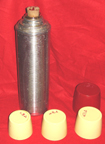
Inside the Outing Kit
(left) 1 quart Wide Mouth Food Jar Thermos #6074
(middle) Sandwich Box and Plates
(right) Beverage Container (Thermos No 2464) and Nesting Cups
Click to Enlarge
Here are the labels that were attached to each of the bottles:


Labels for the Thermos Bottles
Click to Enlarge
As we were reading E.B. Potter's excellent biography of Admiral Nimitz, we thought of the Thermos Outing Kit. However, some background is necessary to set the stage. At the time of World War II, there was no Pentagon Building. Also, there were no freeways or 14th St. Bridge linking DC and Virginia. Admiral Nimitz was the Commander of the Bureau of Navigation (That is actually the Navy's Personnel Department). The Admiral did a lot of close-in work at the White House, but his staff, records and offices were in the Navy Annex, next to Fort Myer on a hill overlooking the swamp that was to become the Pentagon. When the Japanese attacked Pearl Harbor, Admiral Nimitz had to rush to his office to deal with the inordinate amount of manpower and logistics efforts that were to be required to mobilize the Navy for an all-out war. At the time, the Navy Annex was in the middle of nowhere. So, when the Admiral did not show up for dinner two nights in a row, Mrs. NImitz packed him some food and drove from their house at 2222 Q Street to the Annex. Now, here's the quote:
"... Mrs. Nimitz soon set forth with hot food, a thermos of hot coffee and a thermos of hot soup. This was only the first of several trips she made to the Navy Departmet in an effort to keep her husband and his associates properly fed ..."
E.B. Potter, "Nimitz", Naval Institute Press, 1974
Personally, I'd like to think that Mrs. Nimitz used a Thermos Outing Kit to make these deliveries. Later, Admiral Nimitz would direct the Pacific Fleet in the defeat of Japan. It's good that he didn't starve to death or make terrible personnel decisions due to hunger. So I'd also like to think that the Thermos Outing Kit helped win the war...
In addition to musing over keeping Admiral Nimitz fed, we found this advertisement in a 1940 J.C. Penney catalogue. They called the set "Mr. Picknicker".

"Mr. Picknicker"
Click to Enlarge
$14.95 in 1940 has about the same purchasing power as $300 in 2010 -- this gadget was not cheap. Typical factory wages at that time were about $1.00/hr, so your average fellow would have had to work almost two whole days to earn enough money to buy this.
Click here to look at another type of collectible, or keep on scrolling to view more Miscellania.



Speedy Alka Seltzer
His first name was Sparky
Click to Enlarge
Modified 09-22-2010
Alka-Seltzer is a combination of aspirin (acetylsalicylic acid), sodium bicarbonate (NaHCO3), and citric acid, designed to treat pain and simultaneously neutralize excess stomach acid (the "Alka" being derived from the word "alkali"). It is provided in the form of large effervescent tablets, about 1 inch (25 mm) in diameter, which are dissolved (two at a time for the usual adult dosage) in a glass of water. As the tablets dissolve, the base (bicarbonate) and the acid (citric acid) react vigorously producing carbon dioxide gas (hence the "Seltzer"), which also produces enough agitation to allow the active ingredients to dissolve slowly. The patient then ingests the resulting solution.
In 1951 the "Speedy" character was introduced. Created by George Pal of the Wade Ad Agency as Sparky, the name was changed to Speedy by a sales manager to promote that year's promotional theme of "Speedy Relief". He appeared in over 200 TV commercials between 1954 and 1964. Speedy's body was one Alka-Seltzer tablet, while he wore another as a hat; he proclaimed Alka-Seltzer's virtues and sang the "Plop, plop, fizz, fizz" song in his high, squeaky voice (provided by voice actor Dick Beals).Alka Seltzer was marketed by Miles Laboratories, founded by a "Dr. Miles" who had a theory that all ills were do to excessive acid in the body. He produced a wide variety of nostrums aimed at introducing alkalinity (anit-acids) into the system. While Alka Seltzer has a veneer of respectability, other Miles products sound vaguely suspicious, including Nervine Tonic (largely alcohol), Aspir Mint, Dr. Miles Anti- Pain Pills, and Dr. Miles Little Pills.




Other Miles Laboratories' Products
All nothing more-or-less than aspirin
Click to Enlarge
The product has been extensively advertised since its launch in the U.S. Initially, print advertising was used featuring small comic strips that urged the reader to "Alkalize". The comics featured people with exaggeratedly large heads, possibly a subtle (or subliminal) hint that the product was supposedly a cure for the "Hangover".

Typical Alka-seltzer Print Ad
Click to Enlarge


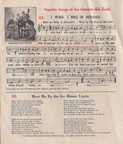
The Alka Seltzer Song Book
Click to Enlarge
We are pleased to be able to offer you two Alka Seltzer advertising classics:
- Excess Acidity Versus Health
- The Alka Seltzer Song Book
Click here to look at another type of collectible, or keep on scrolling to view more Miscellania.

Miss Subways
The Lovely Ms. Linda Heilbronn
Click to Enlarge
Modified 03-11-2009
from the 1940s into the 1960s, New York rapid transit featured advertising cards for the "Miss Subways" beauty contests, a publicity gimmick of the John Robert Powers Modeling Agency. (This was ssuch a New York icon that both the musical and film versions of On The Town have a "Miss Turnstiles" as part of the plot.) The story behind this is amusing:
"... Once there was a young woman - Ruth Ericsson was her name - who worked at the Waldorf-Astoria Hotel filing the nails and pushing back the cuticles of people she imagined were on their way to glamorous nightclubs, expensive restaurants and elegant society affairs. One day, John Robert Powers, of the famous modeling agency, was passing through the hotel and spotted Miss Ericsson. "You are the most beautiful girl I've ever seen," he said to her. "You must be my Miss Subways." She was perplexed, but he placed her photograph in every subway car in New York. She received 258 proposals of marriage, an orchid a day for six months from one smitten rider and, from an adoring bakery truck driver, a lemon meringue pie three feet in diameter. This may sound like a fairy tale, but it's true. ..." (from Ellen Hart's website, link below)
Ellen Hart was "Miss Subway" in 1959 -- she owns a place called Ellen's Stardust Diner on Broadway that is the only place near Times Square to get a good meal at reasonable prices. In addition, the waitstaff are singers looking to break into The Theater and they entertain constantly with songs that are done much better than in some of the plays. She also has a gigantic collection of "Miss Subways" advertising cards. If you ever wondered whether women have improved their lot, look at the slide show in the gallery for a few minutes.
Click here to look at another type of collectible, or keep on scrolling to view more Miscellania.
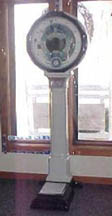
Penny Scales
The Watling Senator Lollipop Scale
Click to Enlarge
Modified 01-28-2009
Patent research can be very instructive. Occasionally, I type the wrong number into the USPTO Patent Search System and something amazing shows up. That's how I came to be interested in Penny Scales -- the coin operated scales that were ubiquitous in restaurants, train stations, drug stores and other public places in the 1950s. In 2009, people are so weight conscious that they would not step on one in public for all the Tea (or steel...) in China. I also note that these vintage scales have a maximum capacity of 300 pounds. Considering the increasingly large number of porkers that I see taking up two seats on the bus, these poor gadgets could be easily maxed out...
Penny scales have been a staple of cartoon humor almost ever since they were introduced. It's always the same gag -- the machine protests that the person standing on it is too heavy. You'd be surprised how many variations there are on this simple theme. Here's an example
A husband stepped on one of those penny scales that tell you your fortune and weight, dropped in a coin, and received a card.
"Listen to this," he said to his wife, "It says I'm energetic, bright, resourceful and a great lover."
"Yeah," his wife nodded, "and it has your weight wrong, too."
The penny scale began as a straight proposition - you give me a coin and I'll tell your weight. Most of these early scales had Neo Classical design elements -- a large round dial on a Greek column. They are known as lollipop scales for their obvious similarity to the candy treat. Later, in order to attract more customers, the proposition changed to "Give me a penny and I'll tell your fortune and weigh you." In addition, the design of the scales came to use more Art Deco elements to add a sense of modernity. The bargain came to include horoscopes, love advice and others in the form of a paper ticket. One model allowed you to gamble, paying a jackpot on random occasions. Most of the manufacturers of Penny Scales also made amusement games and slot machines.
My two scales were made by the Watling Company of Chicago and the C.R. Kirk Company of Indianapolis, and represent both the Neo-Classical (lollipop) and the Art Deco periods. Watling dominated the field. At the height of the "Weight and Fate" craze a wide variety of machines in eye catching color schemes competed for the customer's penny. That said, I'm not going to even pretend to be an authority on this subject. You should go to PennyScale.com to complete your education about these fascinating objects.
First off is the Watling Lollipop Scale, first patented in 1904.



The Watling Lollipop Scale
Design Patent D-46,978 Mechanism Patent No. 1,702,582
Click to Enlarge
Click here if you want to learn how to get Free Patent Drawings
Next is a whimsical Art Deco scale by the C.R. Kirk Company, first patented in 1938.



Kirk Art Deco Scale

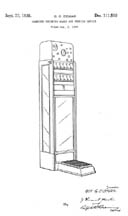
Kirk Design Patent D-110,393
Eidman Design Patent D-111,510 Click to Enlarge
Click here if you want to learn how to get Free Patent Drawings
While we are on the subject of penny-operated devices, you should meet the Automatic Tab Gum Vendor manufactured by the Mills company who also manufactured Slot machines and Pinball Games. This machine was commonly seen in subway stations in large cities such as New York and Philadelphia in the 1940's. A slide lever is moved to select one of six types of tab gum, a penny is inserted and the gum is then released into a tray. The machine uses the very same high security ('Snake Key') style lock as Mill's Slot machines of the 1930's. In the film Somebody Up There Likes Me you can see the young Rocky Graziano (Paul Newman) try to break into one of the Mills Gum Vendors. Here is a photo of a lady using the Mills machine in the New York Subway in the early 1950s. There is a Watling "lollipop" scale in the background that can be partially seen behind the machine.



Mills Automatic Tab Gum Dispenser
Design Patent D-110,497
Click to Enlarge
Click here if you want to learn how to get Free Patent Drawings
Click here to look at another type of collectible, or keep on scrolling to view more Miscellania.

Champion brand metal thermos jug-cooler.
Modified 01-28-2009
Champion brand metal thermos jug-cooler. It is in very good condition for it's age and is ceramic lined. It was made by Metals Industry in Indianapolis. Even the jug caps are intact and in near perfect condition. The thermos jug is 12" tall.. Here is the patent diagram for it.


The Champion Thermos Jug
J.R. Morgan Patent D-110,029
Click to Enlarge
Click here if you want to learn how to get Free Patent Drawings
Click here to look at another type of collectible, or keep on scrolling to view more Miscellania.

The Humble Shirt Box
Click to Enlarge
Modified 01-28-2009
This is an example of dry cleaner's shirt packaging in the distant past. In my memory, only formal shirts came back in a box with a clear plastic window. In general, the design on the box showed elegant folks having a lot of fun in their formal wear. I have this one left over from the 1960s (once they get in the trunk, they stay there...) I was surprised to find that it was patented in 1938.


Folks having fun at a formal affair
Shirt Box Design Patent D-110,742
Click to Enlarge
Click here if you want to learn how to get Free Patent Drawings
Click here to look at another type of collectible, or keep on scrolling to view more Miscellania.

The Motion Picture Theater Seat
Click to Enlarge
Modified 02-03-2009
This is the good old fashioned movie seat that we used to crawl all over during those three hour Saturday Morning Cartoon Shows. The cyber generation will never have the experience of three hundred 7-10 year olds packed in one room. Noise, pandemonium, food fights and the nerdy kid who threw up in the middle of the Serial. This was the place to express your undying affection for the little girl with blue eyes -- by puttting bubble gum in her hair.


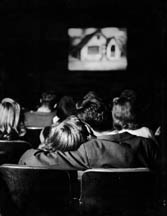
The Folding Motion Picture Chair
Movie Chair Design Patent D-111,485
Movie Chair Design patent D-111,317
As we got Older, We Learned to Put the Movie Chair to Better Use
Click to Enlarge
Click here if you want to learn how to get Free Patent Drawings
Click here to look at another type of collectible, or keep on scrolling to view more Miscellania.

Orange Crush Bottle
Modified 01-28-2009
Orange Crush is an orange-flavored soft drink invented by Clayton J. Powell of Los Angeles, California in 1916. It became very popular in the 1930s when it was sold in an unusual ribbed bottle. These bottles are quite collectible today and the design is patented. The brand has gone through a number of owners including Procter & Gamble and is now owned by the "Dr Pepper Snapple Group" of Plano, Texas.

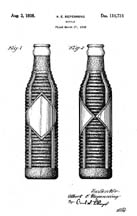

Front and Back of the 1930s Orange Crush Bottle
Orange Crush Bottle Design Patent D-110,731
Early Six-Pack Design, Patent D-110,691
Click to Enlarge
Click here if you want to learn how to get Free Patent Drawings
Click here to look at another type of collectible, or keep on scrolling to view more Miscellania.

Reddy Kilowatt
Designed by Ashton B. Collins c. 1926
Reddy Kilowatt is the "spokescartoon" for America's investor-owned electric utilities. By common convention, Reddy is referred to with masculine pronouns, although the sexuality of creatures made of lightning bolts is somewhat unclear. (Is he AC or DC?) He is drawn as a stick figure whose body and limbs are made of "lightning-bolt" symbols; he has a light bulb for a nose and electrical sockets for ears. He wears genie-like shoes and has horns (also lightning bolts...) Like many cartoon characters, he only has three fingers and wears gloves, to avoid shocking his public. Reddy was created at the Alabama Power Company by Ashton B. Collins, Sr., and debuted March 11, 1926. He was subsequently licensed by some 300 electrical companies in the U.S. and abroad looking to sell homes on using the relatively new technology. He was featured in a 1947 comic book and movie produced by the studio of Walter Lantz.


Mr. Collins' Design Patent (D94261) for Reddy Kilowatt
Click to enlarge either photo
Click here if you want to learn how to get Free Patent Drawings
While Reddy Kilowatt was created as a mascot for investor-owned utilities, a similar character - Willy Wirehand - was created about the same time for use by rural electric cooperatives and public utility districts (evidently, much to Collins' annoyance). Willie was also a stick figure, but with a lamp socket for a head, an electric plug for legs and feet, and wore gloves similar to those worn by farmers.

Willie Wirehand
Spokescartoon for the National Rural Electric Cooperatives Association (NRECA)
Electric cooperatives initially wanted to use Reddy Kilowatt as their spokes character, but Mr. Collins believed that electric cooperatives were "socialistic" because they borrowed money from the federal government. Not only did Collins refuse to let Reddy be associated with cooperatives, he instructed his lawyers to warn the National Rural Electric Cooperatives Association (NRECA) that any rival character they might develop would infringe on his exclusive trademarks. Mr. Collins apparently patented everything that even resembled Reddy Kilowatt:



Mr. Collins' Design Patents D113704,D112515, and D2349706 for Reddy Kilowatt
Click to enlarge any photo
Click here if you want to learn how to get Free Patent Drawings
Believing that Willie — with his UL-approved (for the era) body — was different enough from Reddy, electric cooperatives pressed ahead with his introduction. "Any similarity between trim, efficient Willie Wiredhand and the shocking figure of Reddy Kilowatt is purely coincidental," NRECA said. After several years of angry exchanges, Collins and a coalition of 109 private power companies formed Reddy Kilowatt, Inc. and on July 14, 1953, filed a federal lawsuit against a South Carolina electric cooperative that was using Willie. Their brief accused electric cooperatives of copyright infringement and unfair competitive practices. For relief, they asked cooperatives to scrap any use of Willie in their advertising efforts and to pay damages. The gist of Reddy’s case was not in how Willie looked, but rather private power company concerns that in marketing electricity "Willie’s poses" would cause public confusion. Willie’s attorneys, however, countered that long before Reddy, other animated characters had seen widespread use in the electric industry as trademarks and promotions.
In fact, testimony revealed that Reddy’s handlers had acted like B-grade movie gangsters over the years, using threats of legal action to "unplug" other spokes characters such as Arkansas Power & Light’s "The Willing Watt," Boston Edison’s "Eddie Edison," Bradford Electric Company’s "Mr. Watts-His-Name" and "Elec-Tric" of Cincinnati Gas and Electric.
Finally in June 1956, after a weeklong trial, a federal district court judge in South Carolina awarded the first round of "Reddy vs. Willie" to the cooperatives. Not yet knocked out, Reddy and his crew promptly took their arguments to the Fourth U.S. Circuit Court of Appeals. "This is the most vicious thing that rural electric systems have yet encountered," commented then-NRECA General Manager Clyde Ellis. "We’re not fighting one or 10 power companies, we’re fighting more than 100 of them!"
On January 7, 1957, a three-judge panel from the appeals bench issued a unanimous decision in favor of Willie. The court noted similarities between the two characters but added that Reddy "has appeared in thousands of poses doing almost everything possible and in every conceivable activity. The plaintiff has no right to appropriate as its exclusive property all the situations in which figures may used to illustrate the manifold uses of electricity."
Willie Wirehand continues to be the proud spokescartoon for the NRECA. Reddy Kilowatt was a frequent presence in publicity material until energy conservation replaced energy production as a national goal with the growth of the environmental movement and the OPEC oil embargo. He is now rarely seen. In 1998, Reddy was bought by Northern States Power Company, which created an entire subsidiary, Reddy Kilowatt Corp., to manage the cartoon. That company later created Reddy Flame, a character promoting natural gas. Perhaps Reddy can make a comeback.
By the way, in the USA, you can patent any image -- for your pleasure, here are Mickey Mouse, Betty Boop, and the Golden Gate Bridge:



Design Patents for Betty Boop (D86224), The Golden Gate Bridge (1967381), and Mickey Mouse (D82802)
Click to enlarge any photo
Click here if you want to learn how to get Free Patent Drawings
Click here to look at another type of collectible, or keep on scrolling to view more Miscellania.

Airplane Lamp - Click to Enlarge
Originally Sold at the 1939 World's Fair
This is a gorgeous little table lamp in the shape of a Douglas DC-3. This is fixed-wing, propeller-driven aircraft whose speed and range revolutionized air transport in the 1930s and 1940s. Because of its lasting impact on the airline industry and World War II, it is generally regarded as one of the most significant transport aircraft ever made. Some are still in service in 2009

The Douglas DC-3 - Click to Enlarge
This lamp was designed by Ray Schober in 1938. The lamps have never lost popularity and have been reproduced endlessly. The Sharper Image high-end gadget stores (now defunct) offered a version of this in the 1970s. That version was junky compared to the original and the new ones are even junkier. Here's the original design patent drawing and a photo of a contemporary fake.
.

(Left)Mr. Schober's Design Patent (D-110,196) for the Real DC-3 lamp
(Right) Contemporary Reproduction of the Lamp
Click to enlarge either photo
Click here if you want to learn how to get Free Patent Drawings
Here are some photos that show the insides of the lamp. A real lamp is worth over $500 -- the fakes sell for $30.



Insides of the DC-3 Lamp
Click to enlarge the photos
Click here if you want to learn how to get Free Patent Drawings
Click here to look at another type of collectible, or keep on scrolling to view more Miscellania.


Bauer Chicken of the Sea Fish Plate
Designed by Inez Donen, Manuafctured by Bauer Potteries
Chicken of the Sea Ad, 3-34-41 Issue of LIFE Magazine
Click to Enlarge
I have had this plate in the shape of a fish (left) for nearly 30 years. I got it at a thrift store for about a nickel when I was in graduate school. It has an odd but pleasant shape. I occasionally use it to serve fish but mainly it sits in one of my kitchen cupboards gathering dust. I was really stunned to find this advertisement on page 93 of the March 24, 1941 issue of LIFE magazine (right). The plate could have been yours for 25 cents plus six labels from Chicken of the Sea tuna. The tuna was 10 cents a can, so you would have made a total outlay of 85 cents for the plate. If you could have purchased $0.85 of gold then (it was illegal, though...), the metal would be worth about $17 now. After being alerted to this, I checked the online auctions and found that one of these had sold for about $25. So, you would have been $8 better off eating the tuna, getting the plate and hanging on to it for 64 years...
The ad says "See outsert on top of tuna cans for other valuable pottery offers." I have managed to track down a few of the other other fish-shaped items, principally salt shakers and tuna-bakers. It looks like Chicken of the Sea could have switched from Bauer to Homer Laughlin because the later premiums have the Fiesta colors. The marks on the bottom do not indicate either Bauer or Fiesta.


Ads for Salt Shakers and Tuna Bakers


Additional Valuable Pottery Offers
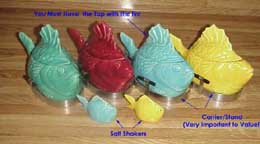
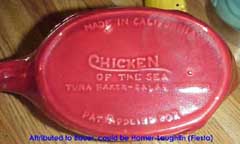
Aids to Authenticating Shakers and Tuna Bakers
Click to enlarge the photos
If you are going to buy one of these, make sure that the Tuna Bakers have the lid (with the fin) and the little metal stand. Don't pay full price if they are not complete.
I am not really into collecting china or glass. maybe one of my more knowledgeable readers can shed additional light on this subject.
Click here to look at another type of collectible, or keep on scrolling to view more Miscellania.

The Run-Out Groove
Even Little Things Have a Story
Many of you have never heard music played from a "record". Some of you may have heard music from a vinyl "LP" record, but it is odds-on that very, very few of you have heard music played on a 78 rpm shellac disc. I am very grateful to Rob Bamberger of radio Station WAMU for supplying me with a scan of the label for Artie Shaw's rendition of "I'll Be Seeing You in Apple Blossom Time" [Vocalion 4438].
The "Run-out Groove" and "Terminal Circle" are shown by the red arrows in the picture.
Let us now go back to May 19, 1924 and listen to the exact words of Frank C. Hinckley of Stratford, Connecticut as he describes the role of the run-out groove:
" ... In the manufacture of phonograph records, there are a number of blank or "music-less" grooves at the end of each record. These are put there for several reasons among them the inability of the operator of the recording machine to raise the recording stylus from the 'master-wax' immediately afterthe last note is recorded; for during recording the movement of the master wax under the needle is at great speed, nearly 4 ft. per second, or more than a full revolution. Then, too, the operator is required to wait until all echoes and other sounds have died down before removing the stylus from the wax; hence we find on each record several of these blank grooves at each end...
"...These grooves offer the serious objection of making easily audible the scraping sound of the needle across the record surface which sound had been made largely inaudible throughout the rest of the record by the music recorded thereon...
"... When a needle has entered the 'terminal circle' of an ordinary record, there is, in addition to the scraping sound, a distinctly audible clicking sound caused by the needle engaging the end or tail of the cross-over groove that leads to the terminal circle...
"... The needle travels over the terminal grooves many more times than it travels over the sound grooves because it must stay there until the needle is raised or the record stopped. In this way, the needle wears away the hard outer surface of the record and contacts the softer low-grade material forming the core. Such low-grade material soon presents a rough surface for the needle to travel on and the noise is increased ...
"...It quite often happens that the needle jumps the wall at the inner side of the terminal groove and skids across the record, mutilating the label...
"...The foregoing and other evils are corrected by this invention..."


Frank C. Hinckley's (1927) Patent No. 1,625,705 for the Run-Out Groove
Correcting Evil Wherever It May Be Found...
Click to Enlarge
Click here if you want to learn how to get Patent Drawings
Here is a summary of recording technology in the late 1930s entitled "Off the Platter and Into Your Home" that was published in the December, 1938 issue of Popular Mechanics:
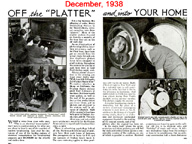
Recording Technology in 1938
December, 1938 issue of Popular Mechanics
Click to Enlarge
We have scanned the entire article and you may download it by clicking here.
Perhaps the most famous "Run-Out Groove" is on the British release of the Beatles Sergeant Pepper's Lonely Hearts Club Band album. (There will be many of you who may not have ever heard the Beatles... for those of you who have not, "The Beatles" was the band Paul McCartney was in just prior to "Wings".) Here's what Mr. McCartney has to say about it:
"... Around the time of Sgt. Pepper's release, a lot of record players didn't have auto-change. You would play an album and it would go, 'Tick, tick, tick,' in the run-out groove - it would just stay there endlessly. We were whacked out so much of the time in the Sixties - just quite harmlessly, as we thought, it was quite innocent - but you would be at friends' houses, twelve at night, and nobody would be going to get up to change that record player. So we'd be getting into the little 'tick, tick, tick,': 'It's quite good, you know? There's a rhythm there.' We were into Cage and Stockhausen, those kind of people. Obviously, once you allow yourself that kind of freedom . . . well, Cage is appreciating silence, isn't he? We were appreciating the run-out groove! We said, 'What if we put something, so that every time it did that, it said something?' So we put a little loop of conversation on..."
When I was in college, I would listen to Sgt. Pepper with my head between two loudspeakers, preferably with a big plate of Oreos nearby. I always thought that the snippet said "Never bothered anybody."
BUT, Karen, one of my dedicated readers points out that my hearing had been seriously damaged either by excessive volume or smoking bananas. She notes that the coreect line is actually "Never to see any other way." Thanks, Peace and Love to Karen!
Record collectors are always on the lookout for Elvis Costello's second album, This Year's Model on Radar Records. The original LPs contained the following text etched next to the run-off groove on side 1:
Ring Moira on 434 3232 for your special prize".
The first few people (believed to be limited to 1000) who phoned in received a photo (with printed autograph) and a badge with the text "Made In 1955 For 1984".
Recently, I received a note from a reader,Steve, who notes that:
"... Another group of interesting, obscure, and funny run out grooves is on the Eagles last 3 albums:
Believe it or not these seemingly silly statements meant something and continue to have meaning today. During most of their careers the Eagles have taken a bad rap for being too sterile and stiff on record but that's what I like myself ..."
In general practice, copyright and technical information are often etched on the record near the run-out groove. Serious record collectors are alert to these details as they can be used to separate rare recordings from fakes.
Click here to look at another type of collectible, or keep on scrolling to view more Miscellania.

Polar Bear in Stride
The Ultimate Art Deco Animal
.
This is a very important figure to me. I just bought it at the New York Metropolitan Museum of Art. There is nothing particularly scarce about it but it has a special meaning to me. This was the very first Art Deco object that penetrated my consciousness. When I was about 8 years old, my third grade class was put on a field trip to the Carnegie Institute (museum) in Pittsburgh. Apparently, I became fixated on this sculpture (a reproduction...) and insisted on staying and looking at it to the point of seriously inconveniencing the teacher who was in charge. Apparently, I made such a fuss that my Mom had to be called to drag me home. In the interval, I sat with the Polar Bear and a nice lady from the Museum who said the magic words "Art Deco". While on a trip to the Met a few weeks ago, I made an impulse purchase of this little reproduction and now I can look at it every day.
FRANCOIS POMPON (1855-1933), French sculptor, student of Rodin and famous for his stylized animal figures. Son of a cabinet maker, he entered the school of fine arts (Ecole des Beaux-Arts) of Dijon after having earned his living in Saulieu as a stone and wood worker. He studied architecture and sculpture and acquired basic knowledge in engraving. In 1874, he left for Paris and, thanks to contacts with contractors transforming Paris during the Second Empire, was able to produce decorative figures and caryatids for the façace of City Hall. For the next fifteen years, he worked as Rodin's assistant.
He began work as an animalier or sculptor of animals and moved the little village of Pernand-Vergelesses on the Côte-d'Or ("Gold Coast") in the south of France, where he worked in relative obscurity into his sixties. While Pompon was turning out amazing animal figures, the Art Deco fever was beginning to sweep the country. In 1925 Jacques Copeau set up his famous theatre in Pernand-Vergelesses and Canon Kir, the mayor, created the world-famous aperitif that bears his name.



Other works of Pompon the animalier
The Recipe for Kir is: one third blackcurrant liqueur to two thirds Aligoté white wine
At the age of 67, he was encouraged by Rodin to bring his works to the 1922 Salon d¹Automne. L' Ours Blanc ("the White Bear" also known as "Polar Bear in Stride ") was the hit of the show and was immediately reproduced in large quantities. The lumbering strength of the bear's movement conveys its form, mass, and dimensionality, in a unique way but suggestive of Rodin¹s earlier training. His sculpture has a simplified sophistication that would become characteristic of modern sculpture in the early 20th century. During the height of the Art Deco movement in interior decoration, a reproduction of Pompon's Polar Bear was always included somewhere in the room, becoming almost a mandatory statement of the sophistication of the owner.
Today, L' Ours Blanc is a fixture in the entrance area at the Musee d¹Orsay in Paris.

The Original Ours Blanc
The sculpture was the favorite of this beautiful young lady who was on Honeymoon in Paris
I snapped this at the same time her husband took a photo.
There is one point in time when our destiny in life is fixed. Meeting Pompon's Polar Bear was that point in my life.
Click here to look at another type of collectible, or keep on scrolling to view more Miscellania.

OVALTINE
It's 'liscious, Mommy!
Familiar to generations of kids as a chocolaty treat, Ovaltine was originally concocted as a nutritional supplement for those in need of more rounded diets. In the late 19th century, Swiss chemist Georg Wander invented a cheap process to harvest malt extract, a syrup derived from malted barley that's commonly used by beer brewers. The barley was first allowed to germinate, or sprout rootlets, in a moist environment. Wander then used a vacuuming process to dehydrate this softened grain, leaving behind a thick, sweet goo. He hoped this syrup, once fortified with goodies like vitamin D and phosphorous, would someday win the world's battle against malnutrition.
It was Georg's son, Albert, who realized that pure malt extract was unlikely to tempt too many tummies, no matter how deprived they were of vitamins and minerals. In 1904, he created Ovomaltine by adding ingredients like sugar, whey, and beet extract to his father's creation. He marketed it to Swiss consumers as an energy booster. An instant hit on ski slopes, where the nutty-tasting brew was served piping hot, Ovomaltine was exported to Britain in 1909 and redubbed Ovaltine. The more beloved cocoa-enriched version came along a few years later.

Cole Porter
Ovaltine is the "Tops"
Ovaltine occurs in the lyics of Cole Porter's very famous You're the Tops, a compendium of superlatives in the mid 1930s:
You're the top! you're the Louvre Museum,
You're the melody from a symphony by Strauss,
You're a Bendel bonnet,
A Shakespeare Sonnet,
You're Mickey Mouse!
You're the Nile! You're the Tow'r of Pisa,
You're the smile, of the Mona Lisa!
I'm a worthless check, a total wreck, a flop!
But if baby I'm the bottom,
You're the top!
You're the top, you're Mahatma Gandhi,
You're the top! you're Napoleon brandy,
You're the purple light, of a summer night in Spain,
You're the National Gallery, you're Garbo's salary,
You're Cellophane!
You're sublime, you're a turkey dinner,
You're the time, of the Derby Winner,
I'm a toy balloon that's fated soon to pop;
But if baby I'm the bottom you're the top!
You're the top!
You're a dance in Bali.
You're the top! You're a hot tamale.
You're an angel, you simply too, too, too diveen,
You're a Botticelli,
You're Keats, You're Shelley,
You're Ovaltine
You're a boon, You're the dam at Boulder,
You're the moon over Mae West's shoulder.
I'm a nominee of the G.O.P. or "GOP",
But if, Baby, I'm the bottom, You're the top!
You're the top!
You're a Waldorf salad.
You're the top! You're a Berlin ballad.
You're a baby grand of a lady and a gent.
You're an old Dutch master, You're Mrs. Astor,
You're Pepsodent.
You're romance, You're the steppes of Russia,
You're the pants on a Roxy usher.
I'm a lazy lout that's just about to stop,
But if Baby, I'm the bottom, You're the top!
Why should that be?? Popular adult lore of the 1930s and 1940s held that Ovaltine mixed with raw eggs gave a powerful boost to the male libido. Here are some ads from LIFE Magazine in 1941 that illustrate the "adult" component of Ovaltine advertising.


Ovaltine as an "Adult" Product
Ovaltine may not have solved the planet's nutrition woes, but it is a lot more wholesome than such sweet rivals as Yoo-hoo and Nesquik. Four teaspoons of Ovaltine mixed with 8 ounces of skim milk provides a solid helping of vitamins A, C, D, B1, B2, and B6, as well as niacin and, yes, that all-important phosphorous. Low-carb dieters beware: The fat content is zero, but malt is an Atkins' diet no-no.
Though an acquired taste, Ovaltine became popular due to clever marketing campaigns in both Europe and the United States. The brand sponsored radio shows, such as Britain's The Ovaltineys (You must visit the Ovaltiney's website!) and America's Captain Midnight. For some strange reason, both shows focused on "secret codes". The British program used a binary cipher and the American program gave away "decoder rings" that accomplished the same purpose. There is a legend that A.M. Turing, the fellow who broke the Enigma Code during World War II was a faithful Ovaltineys listener.

A.M. Turing, a Well-known Ovaltine Fan
Ovaltine was the official tipple of the 1948 Olympics and was carried up Mount Everest by Sir Edmund Hillary in 1953. It is now undergoing a resurgence of interest on the part of consumers.
You may have noted that the structure of "You're the Tops!" is based on analogies, begining from haut culture down to the bas, or popular culture. This indicates that the songwriter, listener and object of affection have the benefit of well-rounded perspective on life. Most of the popular culture items were widely advertised. As we have seen, Ovaltine was well promoted, and Mickey Mouse needs no further explanation.
In the 1930s, Cellophane was a "miracle product" that kept things fresh but was completely transparent. The idea of an invisible permanent barrier struck a chord with people. (By the way, cellophane is a completely renewable and biodegradable product that is made from the cellulose in wood fibers.) Here is an ad from 1941 that touts the miracle virtues of cellophane (although it seems to excuse both littering and smoking...)

Cellophane, the Miracle Product
Littering and Smoking are Apparently Acceptable...
From the March 2, 1941 Issue of LIFE Magazine
Pepsodent was probably the most well-advertised product of the first half of the 20th Century, largely because there is really nothing to toothpaste but sodium bicarbonate and flavoring and the only distinction between products lay within the mind. The makers of Pepsodent realized this and were among the first to use new electronic media as they emerged. You would have to have been blind not to see the gigantic Pepsodent sign on Broadway that used over 30,000 light bulbs. This was one of the very first of these signs to be erected.

The Great White Way, May 1931
Cole Porter Would Have Seen This Every Night!
Check out the American Sign Museum for further details
Later, when radio came along, Pepsodent sponsored the two biggest hits of the 1930s -- the Bob Hope Show and the Amos 'n Andy Show. Pepsodent was almost impossible to avoid and was figuratively (and probably literally) on many tongues. It is small wonder why Cole Porter included it in his list of superlatives.

Bob Hope Promotional Package for Pepsodent
Click here to look at another type of collectible, or keep on scrolling to view more Miscellania.

The Union Label
Hatters, Cap and Millinery Workers International Union
This was submitted by our readers Don and Janice. It is a photo of a label that certifies that their hat was "Union Made" -- it is the emblem of the Hatters, Cap and Millinery Workers International Union. At one time, this industry was very large because both men and women wore hats everywhere. In addition to employing a large number of people, the industry involved a wide variety of materials, including cloth, felt, leather, straw, ribbons, feathers, and the like. Because hats were de rigeur there was a hat store on almost every corner.
Hats were widely advertised, often in full page ads in mass circulation magazines like LIFE


Hats were Big Business
The industry was fiercely competitive and many of the processes - particularly felt -- involved exposure of workers to toxic chemicals. The widespread use of Mercury in several of these processes led to physical and mental disorders that are summarized in the phrase "Mad as a Hatter." Labor and Health conditions led to the formation of the Hatters, Cap and Millinery Workers International Union. This was not without considerable struggle and represented a great forward step for women, who were among the lowest paid and most put upon of the workers in the hatting trades.
For further details on this intersting topic, particularly information on women working in millinery factories, not only straw and felt, but fabric hat factories, and the difficulties they faced in forming unions, please consult:
Robinson, Donald B., Spotlight on a Union: The Story of the United Hatters, Cap and Millinery Workers International Union. New York: Dial Press, 1948. Includes
Today, most of hatting, cap-making and millinery has long since been exported to overseas dictatorships. The HC&M was very proud to have made all the hats worn by the Doughboys in World War I . By contrast, the "berets" that our army now wears are made in China.
The HC&M was merged into the general clothing trades union that is now known as "UNITE!"
Click here to look at another type of collectible, or keep on scrolling to view more Miscellania.

The Original Weed Eater
It Started With a Popcorn Can
Houston businessman, George Ballas, invented the Weed Eater lawn trimmer in 1972, while looking for a solution to his personal grass clipping chores. The idea came to him as he drove through an automatic car wash and watched the spinning nylon bristles clean his car without damaging it. He wondered if he could use the same principle to trim the grass around his trees' trunks without damaging the bark.
Rushing home, he dug through the trash and found a tin popcorn can. He punched holes in it and inserted short lengths of knotted nylon fishing line to simulate the car wash bristles. He attached the can to the rotary on his lawn edger and within seconds the spinning nylon lines neatly sliced through the grass adjacent to a tree. He knew he had found the answer to his prayers and those of millions of other people. Along with Thomas Geist, a Houston machinist, he submitted his Model I patent on December 13, 1971. This design requires you to tie six nylon cords to the rotor. It has no auto feed mechanism, so you would have to take ten minutes to restring the thing about every 15 minutes. Although this made cutting weeds a breeze, it really substituted one kind of mindless labor for another. Mr. Ballas began the slow process of gearing up marketing, engineering and production of his innovative trimmer. He introduced a model with an automatic feed in 1975. This made all the difference! Within four years, sales skyrocketed and Weed Eater become a household name.


The Weed Eater
Ballas & Geist Weed Eater Patent 3,708,967
Ballas Weed Eater Patent 3,859,776
Automatic Line Feed made All the Difference!
Click to Enlarge
Click here if you want to learn how to get Patent Drawings
Mr. Ballas sold the booming business to Emerson, which merged it with Beaird/Poulan to form Beaird-Poulan/Weed Eater. With the combined resources, the company began venturing into other lawn and garden product categories. Poulan/Weed Eater was then purchased by AB Electrolux and operated as a division of White Consolidated Industries Outdoor Products, Inc. until becoming part of Frigidaire Home Products.
Click here to look at another type of collectible, or keep on scrolling to view more Miscellania.


Desk Calendar
The Scimitars are Letter Openers
Click to Enlarge
This is a very nice little desk calendar that I found in a thrift store run by the Episcopal Church. Oddly, it is a Knights of Columbus item. (I collect things from all kinds of Fraternal Orders). The calendar is about five inches high and may be set to represent any month of the year by appropriate twisting of a few dials. The two scimitars that flank the calendar are quite sharp and are intended to be used as letter openers. I was surprised to find this, because the scimitars are usually associated with the Ancient Egyptian Arabic Order of Nobles of the Mystic Shrine, also known as the "Shriners", also known as the fat guys who ride tiny little cars in parades. [That is a joke - the Shriners are the tippy-top of the Masons and pillars of the community. Through lots of hard work, they raise zillions every year for Children. The easy part is riding the little cars in parades.]
Like everything on this site, the silly little desk calendar has a Story.

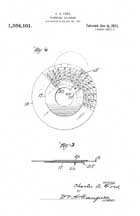
Charles A. Ford's (January 4, 1921) Patent for the Desk Perpetual Calendar
It includes a Cancellation Disk! Click to Enlarge
Click here if you want to learn how to get Patent Drawings
This calendar is the brainchild of Charles A. Ford, a resident of East Orange, New Jersey who described his invention in this way:
"...This invention is an improved Perpetual Calendar which is easily operated on account of its simplicity and has but a few movable parts, the calendar being adapted to be used from year-to-year, the designation of the month and columnar arrangement of dates in each month being movable so that the selected dates can be displayed through an opening in the front sheet....
"...The invention is further designed to provide a calendar in which a Cancellation disk can be swung to cover the 30th and 31st of any month in which such cancellation is necessary..."
Mr. Ford's invention also includes a Pointer that allows the user to focus on a specific day and a clock; the Knights of Columbus did not include these features on their calendar. The thing works very well and is in good shape.
Click here to look at another type of collectible, or keep on scrolling to view more Miscellania.

TV Tables
As Advertised on TV
Click to Enlarge
I am only including this because I saw these tables advertised as a wonderful "new" invention on the Television during the month of April 2005:


Check out www.buytablemate.com if you want one...
Click here if you want to learn how to get Patent Drawings
As as "new" is concerned, they are newer than their 50th birthday... BUT, they do have a proven design that has withstood the test of time.
Click here to look at another type of collectible, or keep on scrolling to view more Miscellania.
The Common Staple Remover
Intellectual Content in Mundane Objects
The Paperless Office may consign this little tool to the dustbin of History, but it actually has a (somewhat) interesting story. For those of you reading this in 2050, back in the dark ages, people used to read things that were "printed" on "paper," an unusual visual interface that relied on applying a chemical substance to a cellulose fiber "screen" -- if the chemical substance was solvent-based ("ink", see below) then the interface was "nonrewritable". Carbon-based substances ("pencil") could be used in the rewritable form of the interface. The cellulose fiber screens had a capacity of about 0.5 KB of information (more if visual displays were used in a ratio of 1000:1). Documents requiring more than 0.5 KB required separate screens. These were generally organized by numbering the screens through a mapping onto the positive integers, although some specialized applications used "Roman Numerals" for segmentation like "introduction" or "prologue." For convenience, the cellulose fiber screens were held together by wire fasteners called "staples." Once fastened in this way, the screens could not be separated without risk of physical injury unless a specialized tool called a "Staple Remover" was employed. The photo above shows this unusual tool.
The Staple Remover reached its final form through the Genius of Joseph A. Foitle of Overland Park, Kansas, who filed for a patent on May 28, 1969. This lovely city (a suburb of Kansas City) certainly bears the mark of Foitle:
Overland Park, Kansas, Zip 66202
The Cutting Edge of Paper Fastener Technology
Click to Enlarge
"... A device for removing broken portions of wire staples.. comprising a pair of overlying planar arms pivoted together on an axis normal thereto, said arms having cooperating notches ...whereby relative pivotal motions.. may be engaged over the projecting portion of a broken staple..."

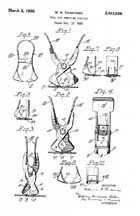

The Improved Staple Remover of Joseph A. Foitle
Pankonin's Original (1936) Patent
Foitle was Standing on the Shoulders of a Giant
Click to Enlarge
Click here if you want to learn how to get Patent Drawings
Foitle's work brings to full fruition the pioneering, but lesser known, work of William G. Pankonin of Chicago, Illinois who worked on Staple Removal at the heart of the Great Depression (No.2,033,050). As you can see, the Pankonin staple removers lack the simplicity that gives panache to the Foitle design.
If you are of this era, please use your staple remover carefully! We would not wish a paper cut on any of our readers.
Click here to look at another type of collectible, or keep on scrolling to view more Miscellania.
The Nimrod Lighter
Truly Windproof!
There was a time (long ago) when I used to smoke a pipe -- mainly because Bing Crosby and Edward G. Robinson smoked pipes. Hollywood iconography of the time generally represented sophisticated upper-class men as pipe smokers, as in Cary Grant's character in Every Girl Should Be Married.
One of the real problems is lighting the darned things while you are outdoors, because you need a flame that burns horizontally. This can be a big problem when your match or Zippo wants to burn vertically in the wind. Enter the "Nimrod" lighter invented by A.F. Ward Jr. of Cincinnati, Ohio.
By the way, the word "Nimrod" as synonym for "hunter", taken from Genesis 10:8-9
"... Cush was the father of Nimrod, who grew to be a mighty warrior on the earth. He was a mighty hunter before the LORD ; that is why it is said, 'Like Nimrod, a mighty hunter before the LORD' ..."
Of all things, Nimrod grew up to build the Tower of Babel, which is something that I might do if my father was named "Cush."

Mr. Ward's Lighter Patent 2,432,265
Just Pull It Apart!
Click here if you want to learn how to get Patent Drawings
The lighter is a marvel of simplicity. One side holds a wick and the fuel -- just regular lighter fluid. You have to unscrew a fitting (15) at the end using a dime as a tool. There is a striker wheel (13) and a Flint (12). To operate it, you grasp each side and pull them apart. This causes the wheel to strike a spark from the flint and ignite the wick. As shown in Fig. 5, the flame burns in a nice wind-proof chamber that fits over the pipe.
They have a kind of nostalgia for me when my Dad and I would rake and burn leaves in the fall. We would smoke our pipes and periodically pass the Nimrod to each other to keep the pipe or the leaves lit. Life evolves: it is dangerous to smoke and it is illegal to burn leaves. But there was a time when Father and Son could enjoy this simple pleasure on a crisp Autumn day, just like having a real job with benefits and a car with a big engine and lots of chrome.
With the decline in smoking, you'd have to go to extraordinary lengths to find one of these. The first alternative is to ty the on-line auctions. They are fetching $10-$20 depending on condition. Thanks to our new friends, the Chinese, you can buy a reproduction at Pipes and Cigars (dot com) and contribute to the balance of payments deficit at the same time. (Our friend Greg sent this along.) Search for JUST the word NIMROD. But, you really shouldn't be smoking...
Click here to look at another type of collectible, or keep on scrolling to view more Miscellania.
Skrip Ink
Filling a Fountain Pen
This is a bottle of Skrip Ink, a magical fluid that was once transported in gadgets called "Fountain Pens." In general, most people today only encounter something like a pen when they sign a credit card receipt. However, our future readers may be denied even this pleasure, because technology is moving towards a virtual signature made with a stylus on a liquid crystal screen. For what it's worth this is ink. At one time, you could buy this at drugstores. The market was once highly competitive as shown by the following ad from LIFE Magazine (The "Gay Style Parade" Included Sapphire). If you want ink now, you have to do some looking. If you live in DC, it's easy -- just go to Fahrneys Pens
Our reader Lisa commented on the search for ink. She writes:
"... as a fountain pen fan bent on luring others into my enthusiasm, let me ask you to note that fountain pen ink (not to be confused with India ink which gums up pens) is still available in major chain office supply stores. (You will need to hunt elsewhere for the full range of colors and brands -- but bottles of ordinary black fountain pen ink from two or three of the major ink makers, suitable for all fountain pens, is no struggle to find.) ..."
Sheaffer's Skrip was one of the more popular brands, mainly because it had this "Easy-Fill" reservoir in the bottle. [With the cap on] You invert the bottle, turn it right side up and a nice little well of ink is available at just the right depth to fill your pen without making a mess.


The Ink Market Was Once Competitive
Mr. Owen E. Raab's Patented Ink Bottle (No. 1,759,866)
It Makes it Easy to Fill Your Pen
Click here if you want to learn how to get Patent Drawings
Society is indebted to Mr. Owen E. Raab of Seattle, Washington for the invention of a "significant improvement in combined wells and bottles". His Patent No. 1,759,866 was granted on May 27, 1930 and signalled the demise of the penwiper industry.
Click here to look at another type of collectible, or keep on scrolling to view more Miscellania.
The Rubber Hot Water Bottle
Commonplace Items Have Inventors, Too!
This is your everyday garden variety Hot Water Bottle. Actually, it's sort of a rubber bag -- before this was invented, there were actual glass and ceramic bottles that would be filled with boiling water to provide a portable source of heat. Today, the Hot Water Bottle has largely been superseded by electrical heat pads or "instant heat" chemical packs. When I was a kid, this was just the thing for an earache -- unless, of course, it leaked...

Ms. Earla M. Roberts Patent (1939)
A "Water Bottle or Similar Article"
Click here if you want to learn how to get Patent Drawings
If you need some trivia for Women's History Month, you can unequivocally state that "The Hot Water Bottle was invented by a Woman." The design which is instantly recognizable across the world was invented by Earla M. Roberts of Lancaster, Pennsylvania. At the time, Ms. Roberts was an employee of the Armstrong Cork Corporation of Lancaster. She received her patent on December 26, 1939 -- a sort of Christmas present from the Patent and Trademark Office.
Click here to look at another type of collectible, or keep on scrolling to view more Miscellania.

Snowshoes
Ready-made for the Winter of 2002-2003
I found these two snowshoes at an antique mall in Fredericksburg. They are NOT a matched pair, although they appear to have been used as one. They contain a marking that says:
BQMD
29
This means "U.S. Army, Boston Quartermaster Division." ( There was a Portland Quartermaster Division also...)
That is, the snowshoes were used by the U.S. Army's elite 10th Mountain Division, probably in World War II. This was the only pair of snowshoes that I have seen that has the bindings still attached. When we got two feet of snow in February of 2003, I was sorely tempted to take them off the wall and use them...
The shoe on the left in the photo was made by Snowcraft, Inc of Norway, Maine. The one on the right is marked "F H CO, Wallingford, Vermont US"
Here is a whole page on snowshoes from WWII.
Here is a page from the Quartermaster's Museum website that discusses the special meals that were formulated for moutntain troops. Here's a history of training for the Army Mountain troops.
Click here to look at another type of collectible, or keep on scrolling to view more Miscellania.

"Wilt" Luggage
Ready to go in the trunk of your Duesenberg
This gorgeous photo was sent to us by the amazing 40s Phil from indiana. Phil writes: "Here's what you need for those weekend dance outings ........ streamlined WILT luggage. I really don't have any information on this set ..... it looks like expensive luggage."


"WILT" Luggage Emblems
The awesome power of the Internet can be seen in the following letter. We asked our readers to tell us more about Wilt Luggage. We received this from Terry:
"... The [Wilt Company] made trunks (Steamer and Bridal) in the beginning from the mid to late 1800's . I have found 3 different addresses for the company in Chicago. Charles Wilt was from New York and moved to Chicago. He looks to have died about 1900 and his wife Emmerette about 1911. A son Capt. Charles 2nd carried on the company and I have just found that Charles IV carried on the luggage company after he got home from the war in Germany and he lived in Lincolnwood ILL. My wife's grandmother was Evelyn Wilt from New York. We have been trying to find a trunk or luggage made by the company for some time. If you ever come across something let me know if we can buy it from the owner..."
We also received this note from Roz:
"... I have some information aabout this luggage, in fact I still own some of their pieces that were purchased in Chicago in 1944 from their store on Michigan avenue [in Chicago] It was the top of the line and very exclusive and expensive at that time. It had lots of built in acccessories inside, leather corners and handles and the bigger pieces had what was called a keyless lock that used a combination of numbers to open it. It was set at the store so that only the owner could open it. It was the forrunner of the now popular combination lock. It was built out of wood and a special kind of plastic covered canvas. It was built for use on trains in cars, too heavy for airplanes. Mine is still in good shape and usuable but too heavy..."
We also received this from Kymri:
"... I am a long lost descendent of Charles Thomas Wilt, who founded and operated the Wilt Luggage Company at 232 S. Michigan Avenue in Chicago. The store finally closed it's doors in 1983/84, and the last Charles Wilt died at 97 years old. I have the same sleek Wilt luggage you wrote about, tags and all, plus a few other pieces of various styles but in poorer condition. My grandmother traveled the world by steamership with Wilt steamer trunks, and my father crossed the country on Route 66 with his own set of Wilt luggage. At one point there was a Wilt Luggage Company shop in Los Angeles. The luggage was used in the movie "Some Like It Hot" with Marilyn Monroe. Coincidentally, my father was an extra in scenes at the Hotel Del Coronado, where the movie was made. I managed to inherit only very worn and handed down pieces of Wilt luggage. However, I also inherited my father's and grandmother's slides from their world travels in the 30's, 40's 50's and 60's. I also inherited the Wilt family tree albums, with photographs and family notes/journals dating back to the early 1800's, and back to Cardiff, Wales. It's no wonder that I'm a professional travel photographer and world traveler....it's in my blood! ...
The Wilt family has a lot of descendants! We received this from Roxie:
"... I'm a decendent of Charles (Chas) T Wilt. Most of the information I have comes from my Great- Grandfather Ted Wilt, who owned a branch of Wilt Luggage in Evenston Ill. Wilt Luggage started in NYC, the first building was right under what is now the Brooklyn Bridge. I forget where it moved to in NYC next, but Chas was a neighbor of P.T Barnum and his mususum. He commissioned Wilt to make a set of luggage for Jennie Lind. I don't remember exactly when Chas T Wilt moved to Chicago, but I do know some of the people he made luggage for were very well known. including : Abrahm Lincoln ( Hat Box), Teddy Rovevelt, the Zigfeild show girls, Nelly Bly, Annie Oakly and many more. Wilt became a very promininet luggage maker, despite the lack of info about the company now. Personally, I own a 1930s Wilt train case, 2 green 1960/70s suitcases, and two yellow 1960s/70s suitcases. ..."
Here are some wonderful memories from Susan,one of their employees:
"... I was reading with great interest your information on Wilt luggage and their descendents. I worked Mr. and Mrs. Wilt in their store in Evanston, Illinois. I worked for them between 1982 – 1986. Their luggage store was a delight. These are the tidbits I remember most about them:
- They celebrated their marriage on the day of the Kentucky Derby – no matter what day it was. Mr. Wilt would get a red rose rose for Mrs. Wilt, and she would walk around the store with delight every time the derby came around. I think they were married for over 50 years when I met them – oto me at such a young age (18-23) they seemed like they were married forever.
- I am from Nashville and lived in Evanston for many years. They took an interest in me because their son Toby was a kicker for the Vanderbilt Commodores. They even sent me to the Liberty bowl courtesy of their son the only year I can remember in ages that Vanderbilt went to a bowl game.
- Mrs. Wilt was a cracker jack business person, and would bargain with many of her customers. She would hand set the monogram machine which was an ancient leather burner that would heat the metal typeset. When hot, she would press the super hot keys into the leather. She taught me how to rub gold leaf into the monograms.
- Mr. Wilt would wear a commodore hat nearly every day that I knew him and Mrs. Wilt would wear the most beautiful scarves. Both would convince the most finicky of buyers that their luggage was a better buy even though there were other luggage stores in the area.
I just love that you have information on them up – please let me know if there is more ...
Can anyone tell us even more about this company??Click here to look at another type of collectible, or keep on scrolling to view more Miscellania.

The V-715 Radiation Detector and Dosimeter Pens
Modified 09-03-2008
You might be interested in this as a sidebar to the Cold War.
During the 1950s and 1960s, the US Government stockpiled a variety of radiation detection devices to be used in times of Nuclear Emergency.
I was in Roanoke over the 2008 Labor Day weekend, and stumbled upon an auction of "Surplus Federal Property" Apparently, the local FBI office was moving and shedding excess baggage. Among the items were confiscated "pornography" (actually cheesecake pictures that are tame by Victoria's Secret Catalogue standards) priced by the pound, lots of file cabinets, chairs, etc, and the aforementioned radiological instruments. For a grand total of $6, I came back with a pound of ill-focused photos of not-so-attractive women in underwear and a "Radiological Survey Meter, OCD Item No. V-715, Model 1-A" -- new in box with two very old Eveready D Cells -- accompanied by seven dosimeter pens and their charger.
Check out this website for a more detailed discussion of the Civil Defense Radiation Detection Devices. Click Here to download a free copy of the V-715 Operator's Manual.
It turns out that the V-715 is an ion chamber that doesn't even begin to register until the Geiger Counter is off the scale, possibly for use by the cockroaches after everyone else had died...
Geiger counters were very big in the 1940s as prospectors sought uranium to become overnight millionaires. This was a lot easier than prospecting for gold or silver since the instrument did all the work.


There's Money (and Radioactivity) in Them Thar Hills
From the February 1949 Issue of Popular Mechanics
Click Here to Read the Whole Article
Click here to look at another type of collectible, or keep on scrolling to view more Miscellania.


The Poker Chip Holder
Click to Enlarge
Poker Chip Holder
Loaded 10-01-2002
These were found in a box on Bulk Trash Day in Chevy Chase, Maryland. This is a macho item suggesting evenings when "the boys" would gather to smoke cigars, drink beer and play poker. Of course, we're too busy dancing to use this, but it is a great artifact of another era.

Yes, You Can Patent a Poker Chip
Poker Chip Design Patent D-111,273
Click here to look at another type of collectible, or keep on scrolling to view more Miscellania.

THE Industrial Designer
Raymond Loewy Artifacts
Loaded 02-19-2009
Raymond Loewy was an influential designer of the 1920s through the 1970s. He may have coined the term "Industrial Design" -- he certainly was successful, because his mark is all over our society today. He even got his picture on the cover of TIME Magazine, surrounded by images of all the wonderful things that he created. (Actually, Loewy created the oustide of most of these wonderful things; the inside was created by more plebeian engineers.) We have alot of Loewy patents and collecibles on our Streamlined Locomotives Page, reflecting Loewy's monumental contribution to transportation. Below are some of his more domestic creations.


Loewy and Tobacco
(left) Cigarette Lighter for Rosenthal
(right Lucky Strike "Flat Fifties" Package
Click to Enlarge
Click here to look at another type of collectible, or keep on scrolling to view more Miscellania.

Miner's Safety Lamp
Click to Enlarge
Miner's Safety lamp
Loaded 10-01-2002
This is another treasure from Bulk Trash Day in Chevy Chase. This is a Safety Lamp used by coal miners; the flame will not ignite methane in the air. Click here to learn how these lamps work.
This particular item marked with the following:
Scranton, Pa
It is nine inches high, and 31/2 inches in diameter at the base. The base is brass, the hood is painted black.
Click here for more photos of Miner's Lamps; This Site also has a lot of interesting photos --- it makes you appreciate how difficult and dangerous coal mining was.
Click here to look at another type of collectible, or keep on scrolling to view more Miscellania.

"Fraidy Cat" Bookends
Click to Enlarge
Modified 04-03-2002
This is a Cat Bookend Set designed by Walter van Nessen, Chase Art metal catalogue #17042 in polished chromium with a black nickel base. 4 inches wide, 7 3/8 inches high. Mr. van Nessen was awarded U. S. Patent #D-88,833 for this on December 27, 1932.

Stylzed Cat Bookend
Mr. van Nessen's Design Patent D-88,833
Click to Enlarge
Click here if you want to learn how to get Patent Drawings
I bought this in Toronto in 1977 for $2; The book Art Deco Chrome by Jim Linz (Schiffer Books, ISBN 0-7643-07444-4) P 163 values this at $450. There is also a black nickel doorstop in this design.
Click here to look at another type of collectible, or keep on scrolling to view more Miscellania.


Chrome Scroll Bookends
Click to Enlarge
Modified 04-12-2002
This is a pair of very lovely scroll bookends by designer Fred D. Farr, made by the Revere Corporation. They have a nautical them, red for "Port", black for "Starboard". Patent number D95,811 for these was issued on June 4, 1935.

Chrome Scroll Bookends with Nautical Motif
Mr. Farr's Design Patent D-95,811
Click to Enlarge
Click here if you want to learn how to get Patent Drawings
More variations on this theme may be seen in the book Art Deco Chrome by Jim Linz (Schiffer Books, ISBN 0-7643-07444-4) P 175 They are valued at about $50.
Click here to look at another type of collectible, or keep on scrolling to view more Miscellania.

Tom and Jerry Zoot Cat Cartoon Lobby Card
Click to Enlarge
Modified 04-12-2002
This is a poster for the 1944 MGM cartoon The Zoot Cat featuring my faves, Tom and Jerry. In the story, Tom loses a very pretty girlfriend because he is stuck in the Rudy vallee/Charleston era. Tom vows to get her back; he roams troough the house and makes a zoot suit out of odds and ends (a striped hammock provides the fabric for his coat and a lampshade is smashed own to make his Tando). Jerry cosnistently foils Tom's amorous advances. This is the only film in which the cat and mouse actually speak. You can watch it on You Tube.
Click here to look at another type of collectible, or keep on scrolling to view more Miscellania.

Chrome Sailboat Model
Click to Enlarge
Modified 04-03-2002
This is a very beautiful chrome sailing boat. The sails actually adjust and the hull appears to be heeling over at the waterline. It is unmarked, but is shown in The book Art Deco Chrome by Jim Linz (Schiffer Books, ISBN 0-7643-07444-4) P 175 It is valued at $25.
Click here to look at another type of collectible, or keep on scrolling to view more Miscellania.
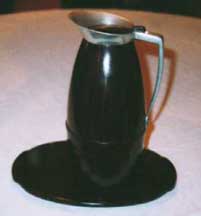
Thermos Carafe
Click to Enlarge
Modified 04-03-2002
This is a Thermos Model 1542 Bakelite and aluminum desk carafe set. An advertisement for the Thermos Corp is shown with a similar set in Art Deco Chrome by Jim Linz (Schiffer Books, ISBN 0-7643-07444-4) P 97
Click here to look at another type of collectible, or keep on scrolling to view more Miscellania.


The Bates Address Book, (Closed and Open)
Click to Enlarge
Modified 03-05-2011
This is a little Bakelite address book. It has a sliding lever to get to the desired part of the alphabet. One presses a trigger and it opens to the desired spot. These used to be very common, but are quite rare today.



Mechanism and Exterior of the Bates Address Book
Mr. Reuben H Chambers' Mechanism Patent D-110,241
Pollock Address Book Exterior Patent D-110,007
Bates Book with Clock Design Patent D-111,610
Ad for and Address Book Using the Chambers and Pollock Patents -- an "Answer to a Prayer"
Click to Enlarge
Click here if you want to learn how to get Free Patent Drawings
The triggering device was invented in 1938 by Mr. Reuben H. Chambers of Washington, D.C. He submitted his original design (probably along with his Tax Return on April 15, 1938. He was granted Patent 110,241 on June 28, 1938 -- this is sort of a record for patents, only two months. The Chambers device is part of the address book although it is encased in the lovely plastic housing that was designed by Albert Pollock.
Here is an adverisement for an address book using Mr. Chambers' patent that appeared in the November 17, 1939 issue of LIFE Magazine. Also shown is an article from the issue of Popular Mechanics touting the virtues of this mechanism.


Mechanism and Exterior of the Bates Address Book
Mr. Reuben H Chambers' Mechanism Patent D-110,241
Pollock Address Book Exterior Patent D-110,007
Bates Book with Clock Design Patent D-111,610
Ad for and Address Book Using the Chambers and Pollock Patents -- an "Answer to a Prayer"
Click to Enlarge
Click here if you want to learn how to get Free Patent Drawings
Click here to look at another type of collectible, or keep on scrolling to view more Miscellania.
Well, I don't know whethery "Quackery" is appropriate --- let's say that these are 1940s "Home Health" or "Lifestyl" appliances. I am looking at the front section of the Washington Post, and I see ads for things like a Paraffin Spa, a White Noise Fountain, and, of all things, an Electric Massager. So, the items shown below are not so strange when put into their contemporary context. (Lord knows what folks will make of aromatherapy fifty years from now...)

The "Roll-a-Ray"
Made by the S.A. Sutton Corp. of Wichta, Kansas
Click to Enlarge
This is amazing! There is a sun-lamp bulb hidden inside this thing. You can roll the thing on your body and it gives you a massage and a suntan at the same time!
During the winter holidays of 2001, I received a wonderful book:
Bakelite Style edited by Tessa Clark. 1997, Quintet Books, Edison, NJ ISBN # 0-7858-0876-0
Although this is a wonderful book in its own right, I was THRILLED to find a picture of my Roll-a-Ray on page 215!! Here is what the eidtors had to say:
Discovered among a selection of Irons, the function of the Roll-a-Ray by the Sutton Corporation remains somewhat of a mystery! The streamlined body holds a light bulb and is propelled along on rubber wheels, ultimately designed to massage your back. Made from phenolic and rubber in the late 1930s.
Some research on the internet brought the Roll-a-Ray into more focus:
- From Senior Network: "Why do consumers fall for these gadgets? The FDA says that belief is still a major factor in the success of health fads and cults. The Chiropra therapeutic comb was banned for false claims that scratching with it was effective treatment for many diseases. A 34-page brochure sold with the comb recommended body areas to be scratched for specific ailments. How about the Roll-A-Ray? It was claimed to be effective for removing unsightly bumps and bulges. An ordinary light bulb was mounted behind two rubber rollers in a plastic case resembling an iron. Instructions were hardly necessary-just iron your fat to make it melt away. "
- From Scientific Review of Alternative Medicine: "At the Saturday night banquet Robert McCoy, proprietor of The Museum of Questionable Medical Devices in Minneapolis gave an entertaining presentation on Quack Medical Devices. He showed a large assortment of the medical devices from the museum including: a prostate gland warmer, used to treat the 'abdominal brain'; a Specto-Chrome, which claimed to cure everything, including cancer, with colored lights; a Nose Shaper that you strap on your face and tighten tiny bolts to push your nose into position; and a foot operated breast enlarger pump. In addition to the actual devices, Mr. McCoy has an encyclopedic knowledge of some of the stories of famous quacks, such as John Harvey Kellogg. He even had personal tales, such as one where a man who had sold a bogus weight loss device called the Roll-A-Ray admitted to Mr. McCoy that he knew the device was bogus. After twenty years of selling it, his conscience got to him and he quit the business. He's now retired, living in Florida. "

The Westinghouse Health Ray Lamp
Type UIF ST1372965
Click to Enlarge
I found this amazing item at Greybeard's Antiques just outside Shrewsbury, Pa. This is quote old --- it has a sticker fom the "Bandor Furniture Stores" that is distinguished by the fact that the phone number for each branch is of the old "Number Please" variety --- before dialing!. The phone number of the Parkville, Md store is "BLVD 14575" and the phone number for the Towson, MD store is "Towson 2416")
This odd device has two light bulbs. The Switch Plate indicates that you can choose between the "Sun Ray" and the "Heat Ray". All of this business about "Rays" comes from popular fascination with the therapeutic benefits of X-Rays and other forms of radiation therapy. The particular manifestation on this light comes from the belief that exposure to Ultra Violet light (solar radiation) was good for you --- it was assumed that the only source of Vitamin D was sunlight. (They had not yet heard of melanoma...) (This uses a RS 275 watt Sunlamp)
The Heat Bulb (Infrared radiation) is for Diathermy, or heat therapy which was applied for stuff like cancer as well as muscle sprains.



(Left to Right)
The Heat Ray end of the light (uses a 250 Watt Heat Ray Bulb)
The lamp with the cowlings off
The details of the lamp ---Not exactly Rocket Science here
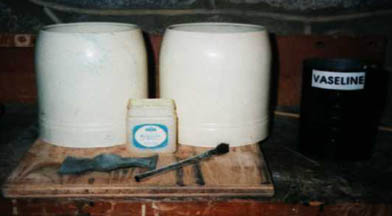
Restoring the Cowlings
Click to Enlarge
Here's a helpful hint --- if you have an enameled surface that has wear and paint drippings, you can clean it very easily with Petroleum Jelly (vaseline) and steel wool. Rub very gently! The left cowl still has paint smudges and dirt. The right cowl has been polished.
Modified 12-18-2001
.
Click here to look at another type of collectible, or keep on scrolling to view more Miscellania.

Heisey "Lariat" Punch Bowl
Click to Enlarge
Modified 11-28-2001
This is a wonderful Punch set. The manufacturer is Heisey and the pattern is "Lariat". It was produced between 1946 and 1949, and is a wonderful 1940s icon.
Click here to look at another type of collectible, or keep on scrolling to view more Miscellania.

Vintage Roller Skates
Click to Enlarge
Modified 11-28-2001
I found this case (and associated old-time skates) in Ellicott City. Of interest is the fact that the previous owner had been a student at the RCA Institute (of radio repair...) and made the skate case out of his student toolbox.
Click here to look at another type of collectible, or keep on scrolling to view more Miscellania.

Bowling Pins
Modified 11-28-2001
With all this interest in Bowling, particularly the "Bop'N'Bowl" dances, it is only proper that a retro collector should have authentic bowling parapernalia. We found this child's bowling set in a thrift store for $10.
Click here to look at another type of collectible, or keep on scrolling to view more Miscellania.

Regular and Duckpin Bowling Balls
Click to Enlarge
Modified 03-05-2011
With renewed interest in Bowling, particularly the "Bop'N'Bowl" dances, it is only proper that a retro collector should have authentic bowling parapernalia. We found these very nice bowling balls and retro bags for about $5 each. [That was 2005, sadly, the Bop'N'Bowl has been demolished and turned into thoroughly ugly townhouses]

Fernando Frillici and Joseph Infantino's Patented Bowling Pin
Actually an "Ionomer Cladded Bowling Pin"
Click here if you want to learn how to get Patent Drawings
Yes, you can patent a Bowling Pin! Here is a modern (1984) patent for a Bowling Pin that is cladded with an "Ionomer Resin" (...an ionic copolymer of at least 50 mol percent of a monocarbon atom, from 0.2 to about 25 mol percent of an alpha, beta ethylenically unsaturated carboxylic acid having from 3 to 8 carbon atoms and, optionally, other monoethylenically unsaturated copolymers...) And you were thinking that Bowling was nothing but beer and cigar smoke! Actually, the Massrs. Frillici and Infantino demonstrate that their improved pin would last a whole lot longer than plain wooden pins AND would give exactly the same average bowling scores. So, this is nothing like a "corked bat". Mr. Frillici was from Fairfield Connecticut and Mr. Infantino was from Chappaqua, New York. This is a first rate job -- yet another contribution of Italian-Americans to a More Abundant Society.
Click here to look at another type of collectible, or keep on scrolling to view more Miscellania.
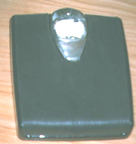


The Detecto Bugeye Scale
left: First restoration middle: Internal components right: the Pink Scale
Click to Enlarge
Modified 8-11-2000
I have been looking for a 1940s bathroom scale for one time. You can imagine my delight when I stopped at a yard sale just outside Gainesville, Va. In addition to the usual junk, there were two wonderful objects: an exotic hand-painted tie and a real live 1947 Detecto "Bugeye" bathroom scale. The tie was in excellent condition; the scale actually worked, but was in atrocious condition. I parted with seventy five cents and bundled my treasure into the car.
Here is an ad for the Bugeye taken from the March 12, 1956 issue of LIFE Magazine

"Detecto" was the brand name of the Jacobs Brothers Ccale Company in Brooklyn New York. The Jacobs Brothers were innovators and prolific inventors. The company merged with Cardinal Scales, manufacturers of heavy duty scales in 1981. The Cardinal/Detecto company is still in business and is still making quality products.


Detecto Scales Patents
Design Patent D-117,273 and Mechanism Patent No. 2,105,219
Click to Enlarge
Click here if you want to learn how to get Patent Drawings
If you want to restore a Bugeye Scale, Click Here to download a ".pdf" of the mechanism patent. It will be immeasurably useful to you.
Bathroom scales live in an environment full of water and humidity. It is extremely rare to find them without a whole lot of corrosion. This example was no exception. My guess is that it had sat fairly undisturbed in a spare bathroom for nearly fifty years. You can't begin to dis-asssemble the scale for restoration until you remove the rubber "tread" from the top. It's glued on and has to be slowly coaxed off with the help of a sharp knife. In all probability, you'll ruin it. No problem -- just use the old piece as a pattern and then buy some rubber tread material at the Home Depot. They sell a material that is very similar to that used by Detecto as a temporary floor covering.
When I opened it, I thought there was some kind of loosely woven "mat" that cushioned the top from the springs. Wrong. This was the most massive accumulation of housedust that I had ever seen. Yecch!
Detecto seems to have pioneered this particular design. If you will look at the exploded view, you will see two pieces (Upper left, lower right) that look like the letter "V". These are two Pivot Bars that are suspended on knife edge bearings (the little things that look like the letter "U".) The top of the scale (lower left) displaces the pivot bars and as they move, a ratchet turns the dial. The large magnifying lens (upper right) enables you to read the scale from a height of approximately five to six feet. The entire scale was thickly coated with rust and had to be returned to bare metal. Modern technology came to the rescue --- an epoxy based paint was applied to all the parts to prevent further corrosion.
According to various sensitive tests, the restored scale works perfectly. I hope to have it serve for another fifty years!
Update August 11, 2000
Of all things, we found ANOTHER Detecto bugeye! This one was in Karen's mother's bathroom --- and we found out that it was purchased in 1948! Well, we don't have a whole lot of opportunity to get into "Mass Production" with these things, so we welcomed this challenge. The restoration goes a whole lot faster once you discover what needs to be done... The scale was painted pink to match the bathroom.
Click here to look at another type of collectible, or keep on scrolling to view more Miscellania.

Flamingo Lamp
You have to see it to believe it... Click to Enlarge
This oddball object was sort of the "Lava Lamp" of the 1930s. Briefly, the "bulb" has an unusual fillament --- it is in the shape of a pair of Flamingoes. Turn the current on, and they glow bright pink. What a hoot!
Click here to look at another type of collectible, or keep on scrolling to view more Miscellania.
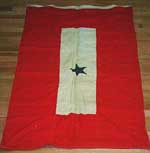
Service Flag
One person in the Service
This is a flag that was flown by houses with a family member in the Service. The single blue star indicates that one member of the family was on active duty. This flag was also reproduced as a window decal. If the person in the armed serves were to be killed, the blue star would be replaced with a gold star.
Click here to look at another type of collectible, or keep on scrolling to view more Miscellania.


45 Star Flag
The Field: Three of 8, Three of 7
This is a remarkable item -- it came from the estate of my Uncle Tony. If you will recall, Uncle Tony was the Musician, Dancer, Zoot-Suiter and general black sheep of my family. My absolute favorite uncle! Well, this part of the story goes back to 1937 when Uncle Tony went West. Largely on the strength of cowboy movies, he moved to Arizona. Just like that!
After kicking around for a while, he landed a job at a general store in a little town called Grier. The store was also the U. S. Post Office for the area. Part of the job required that a U.S. Flag be run up every day. To make a long story short, Tony discovered that the flag he had been handling every day had 45 stars (Three rows of 8 and three rows of seven). He submitted a request to Washington and eventually the store received a 48 star flag (six rows of eight...). Uncle Tony saved the flag. His last wife sent it to me. The flag dates between 1896 (when Utah became the 45th state and 1908 (when Oklahoma became the 46th state). It was apparently mistakenly in use for nearly 40 years. I'm surprised that it only has one small tear!
In Case you're interested...
- 1776The Grand Union flag is displayed on Prospect Hill. It has 13 alternate red and white stripes and the British Union Jack in the upper left-hand corner (the canton)
- 1777 Continental Congress adopts the following: Resolved: that the flag of the United States be thirteen stripes, alternate red and white; that the union be thirteen stars, white in a blue field, representing a new constellation. (stars represent Delaware, Pennsylvania, New Jersey, Georgia, Connecticut, Massachusetts, Maryland, South Carolina, New Hampshire, Virginia, New York, North Carolina, and Rhode Island)
- 1795Flag with 15 stars and 15 stripes (Vermont, Kentucky)
- 1818 Flag with 20 stars and 13 stripes (it remains at 13 hereafter) (Tennessee, Ohio, Louisiana, Indiana, Mississippi)
- 1819--Flag with 21 stars (Illinois)
- 1820--Flag with 23 stars (Alabama, Maine)
- 1822--Flag with 24 stars (Missouri)
- 1836--Flag with 25 stars (Arkansas)
- 1837--Flag with 26 stars (Michigan)
- 1845--Flag with 27 stars (Florida)
- 1846--Flag with 28 stars (Texas)
- 1847--Flag with 29 stars (Iowa)
- 1848--Flag with 30 stars (Wisconsin)
- 1851--Flag with 31 stars (California)
- 1858--Flag with 32 stars (Minnesota)
- 1859--Flag with 33 stars (Oregon)
- 1861--Flag with 34 stars; (Kansas)
- 1863--Flag with 35 stars (West Virginia)
- 1865--Flag with 36 stars (Nevada)
- 1867--Flag with 37 stars (Nebraska)
- 1877--Flag with 38 stars (Colorado)
- 1890--Flag with 43 stars (North Dakota, South Dakota, Montana, Washington, Idaho)
- 1891--Flag with 44 stars (Wyoming)
- 1896--Flag with 45 stars (Utah)
- 1908--Flag with 46 stars (Oklahoma)
- 1912--Flag with 48 stars (New Mexico, Arizona)
- 1959--Flag with 49 stars (Alaska)
- 1960--Flag with 50 stars (Hawaii)
Now, suppose they admit DC (or Puerto Rico) as a state. What would a 51 star flag look like? How about a 52 star flag?
Click here to look at another type of collectible, or keep on scrolling to view more Miscellania.

Display of Arms
Just like in Castles across Europe
During the eighteenth century a gentleman just wasn't a gentleman unless he had a display of Arms in his castle. All over Europe, you find rooms where swords, muskets, pistols, armor, etc, etc, are artfully arranged on the walls. Although I have no interest in conventional firearms, Ray Guns have always interested me. So, here you will see me exercising my Second Amendment rights to "bare" arms. I may have to register or surrender these a hundred years from now...
Click here to look at another type of collectible, or keep on scrolling to view more Miscellania.
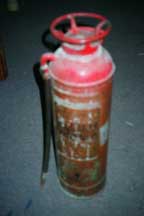
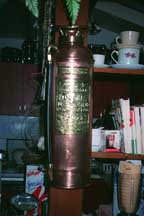
The Stempel Soda-Acid Fire Extinguisher
A Symphony of Brass and Copper!
Click to Enlarge
This is the classic fire extinguisher that adorned the walls of public buildings throughout the country. The gizmo is a sealed container that holds a solution of sodium carbonate; there is a small glass bottle at the top with a loose stopper that contains weak hydrochloric acid. When the container is inverted, the stopper comes off, the acid mixes with the solution and a foamy solution is made --- with enough carbon dioxide to creat pressure to drive it out the hose and squirt onto a fire. ... or your dorm buddies.
These gadgets are made of pure brass and copper, and were manufactured by the Stempel Corporation of St. Louis, Missouri. When we got it, a safety official had painted the "crown" an obnoxious red. Adding to our difficulty was the VERY effective protective coating that the Stempel company had applied. In order to get it to truly shine, we had to apply a wire brush. This created some scratches which had to be removed by using finer and finer grades of sandpaper, then steel wool and then jeweler's rouge.
We devoted considerable attention to the "crown", a solid bras casting. This serves as both the handle and stand for the extinguisher (when it is inverted) and is the single most recognizable feature of the device. The Stempel company left the casting in fairly rough form. We used a hand grinder to polish it to a mirror finish.
This humble, utilitarian device is an object of true beauty when it is restored to its original shape.
And, speaking of Fire Extinguishers, we got this from our reader Kat:
"... Miracle Brand Fire Extinguisher... stumbled upon your website because I am trying to figure out my weird little fire extinguisher. Would you happen to have seen anything like this or know anything about this? These were located in the house where I grew up in Tulsa, Oklahoma. There were about 5 of them mounted in the attic and they say "Throw at base of flame". It measures about 4" x 8". Luckily we never had to depend on them to fight a fire as they are tiny. We took them when we moved as mementos and now I am trying to find out more about them to share with my siblings. If you have the time will you please send me in the right direction ..."
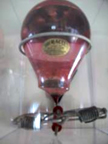

The Miracle Fire Extinguisher
The Liquid Inside is VERY HAZARDOUS Carbon Tetrachloride
Click to Enlarge
These little things were quite common -- they were seen in offices, schools and on ships. I have seen them with the "Red Comet" brand. The liquid is carbon tetrachloride that was banned in 1980 as a carcinogen. The metal spring like thing at the base is actually a "fuse" -- if the temperature goes above 160 degrees, the thing that holds the cage together will spring apart and a rod will shatter the glass. So, you could also hang the things in a hall and they would be automatically set off like a sprinkler. They were manufactured in the period 1900-1925. The technical term is "Fire Suppression Globe"
Click here to look at another type of collectible, or keep on scrolling for more Knicknacks.


Samsonite Series 51 Luggage
...and Ads from the period
We like the ad showing a happy family off on a spree
Click to Enlarge
Samsonite luggage is not hard to find. The unusual thing about this set is that we did not buy it as a set --- we found each of the pieces in different places. The monograms are different on each piece. As far as we can tell, the entire set is practically mint --- no damage whatsoever and the interior linings are in perfect shape. I really like the Bermuda Green color. The set was offered in other colors as well: Rawhide (white),Admiral Blue, Colorado Brown (leather look), and Natural Alligator. I originally posted this in 1998 when we only had three pieces. As you'll see below, we eventually found the complete set:
- Series 5111 Train Case
- Series 5121 Overnighter
- Series 5131 Two-suiter
- Series 5141 V.I.P (attache) Case
- Series 5181 Vanity Overnight (hatbox)
Here is a simple guide to serial numbers:
- The first two digits are the style, "51"
- The next digit is the size, "1" = Train Case
- The third digit is the color "1" = Bermuda Green
By the way, if you want to cover your suitcases with luggage labels, Click Here for a wonderful site!
Update # 1
On June 15, 2001 we found the Green Samsonite Attache. I was thrilled to find it!
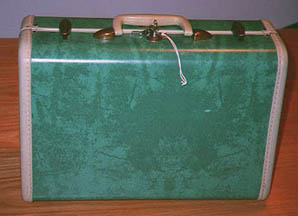
The Green Samsonite Attache Case
Click to Enlarge
Update #2
It took a while, but we finally found the Hatbox (or Vanity Overnight on November 9, 2001. Now the set is complete!!

The Complete Set of Samsonite Series 5000 Luggage Click to Enlarge
Samsonite History
In 1910 the Shwayder Trunk Manufacturing Company of Denver, Colorado began producing an uncommonly well-made trunk that would stand up to the most rigorous travel, originally including the Alaska Gold Rush.
For years, Shwayder marketed only one product --- a trunk named "Samson" that evoked images of the biblical strong man. These were only sold in the western United States and acquired cachet for both their quality and scarcity. After WWII, the company began MASS production using synthetic materials. The name "Samsonite" carried the market power of the company's reputation for quality and prestiege, but also played to the postwar fascination with the discovery of new elements and materials. Samsonite and Kryptonite evoke images of exotic super-powerful materials. To get an idea of this marketing strategy, what would happen if today's up-market luggage maker went after the mass market with "Vuitonium"
This early luggage is actually very well made. This luggage was not cheap. In 1950, the various pieces were about $20 each. According to the ad, the whole set that we have would have cost about $100. In 1950, the tuition to Harvard University was $600. As you read about this in the future, simply take 1/6 of the current Harvard tuition to get an idea of the dent that would have been made in your budget by purchasing this set of luggage.
Update #3
Recently, we found that we were not the only people who collect Samsonite from the "51" Series. here is an adverisement prepared by the National Dairy Council featuring singer/songwriter Sheryl Crow. Please note the presence of the Beruda Green "51" attache and train case in the photo. This appeared in the March 2006 issue of Shape magazine. I liked Ms. Crow much better when she appeared in vintage doing Begin the Beguine in the film Delovely.

Sheryl Crow Votes for Series 51
Update #4
Alas, the stuff is really heavy. In 2010, airlines had reverted to an annoying aspect of the 1950s -- they imposed weight limits on baggage, charging astounding fees for excess. On balance, the rugged construction is probably necessary to survive the simian baggage handlers employed by the major airlines better than the pootsy little cloth and wire suitcases in vogue today.
Click here to look at another type of collectible, or keep on scrolling for more Knicknacks.

Sailor Bank
About 8 inches high
Click to Enlarge
This is one of our most charming pieces. It is a bank, made of a composite material that portrays a sailor carrying a sea bag. This is a coin bank (the seabag holds the coins). I really like the way the artist has captured the sweep of the bell-bottom pants. This is just the kind of thing that a lady would have on her vanity as she thought of her sailor off at sea. We found this in Syracuse.
Click here to look at another type of collectible.

Starlight Globe
From the mid 1940s
This is a Replogle twelve inch "Starlight" globe. It is very distinctive in that the oceans are shown in black rather than blue. The map shows a unified Vietnam as "Indochina", shows India without Pakistan, and shows Palestine not Israel. From this, we date the globe as somewhere before 1946.
These globes are very popular now and one often sees them at Art Deco shows. The Replogle Company (the world's largest makers of globes) has even reissued the "Starlight" model, at about $60. They say: "A Classic revisited. Everything old is new again! One of Replogle's most popular styles in the 1940s and 1950s with today's cartography! A beautiful satin chrome metallic painted base (the original is chrome...) with Gyro-matic mounting complement this striking black ocean design. A distinctive, un-traditional choice for today's retro trend-setters" You can check out their website for more details
While we are on the subject, here is something more elaborate, a globe supported by two atlantides that would have been just dandy for the office of a Wall Street fat cat.

Raymond Dupler Mantel Globe, Patent D-110,351
Click to Enlarge
Click here to look at another type of collectible, or keep on scrolling for more Knicknacks.

Schick Electric Razor
With its presentation case...
Click to Enlarge
Posted January 10, 2002
This is a Schick Super electric razor. My best guess is that this item dates from the mid 1930s. In very small print on the back of the case is this inscription:
Schick Incorporated
Stamford Conn, USA
110-120 volts 14 watts
AC-DC Cat 270 Pat'd
The case is definiely Bakelite and the style matches other razors made in the 1930s. Finally, as discussed on the link below, we also know that Col. Schick moved his plant out of Stamford in late 1939.
Here are some links related to Shaving and Barberiana:
Here is the Warranty that came with the shaver
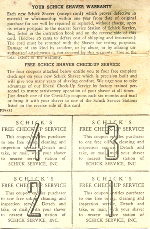


Schick Ephemera
Warranty and Coupons for 4 Free Service Visits
Distributors of Schick Razors
Here is an ad for the Schick Razor from LIFE Magazine, October 6, 1941 plus a look at what the competition over at Remington and Sunbeam was doing.



The Shick, Remington and Sunbeam Electric Shavers
As Advertised in LIFE Magazine
$12.75 in 1941 is equivalent to $267.50 in 2005
Check our Kitchen Mixer Page for a 1947 Sunbeam Price List that includes the Shavemaster
In 1942, Ivar Jepson over at Sunbeam perfected the electric shaver by doing a thorough scientific study of the microdynamics of electric shaving. As shown below (Fig 1), the electric shaver is simply a rotating blade (16) that cuts hair projecting through a mesh screen (33) that is known as the "Hair Comb". Mr Jepson's studies led him to the characteristic shape of the hair comb shown in Fig 3 -- note that there is a mixture of larger and smaller holes, designed to admit whiskers of varying length, trimming a small bit off each one as the shaver is passed across the beard. The particular pattern shown in the diagram is still used in shavers today. By 1942, Raymond Loewy got into the act and created the iconic design for the Schick razor that lasted well into the 1950s.

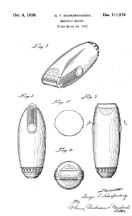

The Electric Razor
Mr. Jepson's Shaver Mechanism Patent 2,345,263
Mr. Scharfenbergs Original Shaver Design Patent D-111,574
Raymond Loewy's Improved Shaver Mechanism Design D-131,928
Click here if you want to learn how to get Free Patent Drawings
I was also stunned to find out that my little razor had been included in the Crypt of Civilization, a sort of 1940 era time capsule stashed at Oglethorpe University. You should check that link out to find out what was thought to be very important in 1940.
Click here to look at another type of collectible, or keep on scrolling for more Knicknacks.


Hair Dryers from Wisconsin!
(left) Hamilton-Beach Hair Dryer from the 1920s
(right) The Race 65 Looks Like a Microphone
Click to Enlarge
Posted January 10, 2002
These two photos span the era when Racine Wisconsin was the "Electric Motor Capital of the World" Handheld hair dryers were first sold by the Racine Universal Motor Company of the US in 1920. Most of the electric motor business left Racine by the 1960s.
The first photo is a very early Hamilton-Beach hair dryer. Believe me, this is built like a tank. It still works just fine. Here is the data from the manufacturer's plate:
No. 5 Hair Dryer
Patent No. 1821525
No. 5H126299B volts 115 amps 3
Hamilton Beach Division of Scovill Mfg Co Racine, Wis,Made in USA
Here is the patent drawing for this hair dryer, as invented by Mr. Emmanuel Nielson of the Hamilton-Beach Company. There is virtually NO technical difference between this hair dryer and the one you can buy today in the drug store. (The major differences are (1) that this one will last forever and (2) this one was made in the USA)
This is simplicity itself -- there is a handle, a fan and a heating coil. Voilla! The Hair Dryer.
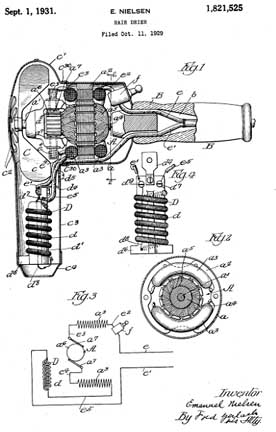
Mr. Neilson's Patent
The second photo is the Race 65 hair dryer made by the Racine Universal Motors Corporation of Racine, Wisconsin in the 1950s. It is so named because it supposedly has 65 uses. Here are some of these suggested uses from the label...
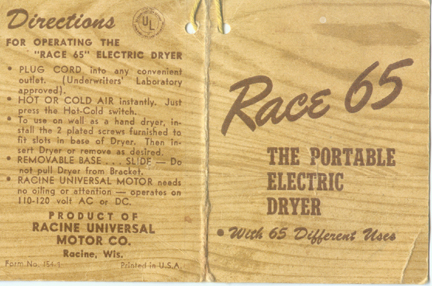

The following information is on the manufacturer's nameplate:
Made in USA, CSA approved, no 8678
Underwriter's Laboratory stamp
110-120 v AC or DC
No. D-23586 Type 9 Max amps 3
Racine Universal Motor Co., Racine, Wisconsin
This might be of interest --- From the late 1920s to early 1950s, Racine was the electric motor capital of the world, according to local historian Jerry Karwowski. "They made more electric motors here than anywhere else," he said. It all started with the United States Standard Electrical Works Co., which was founded in 1904 by Fred Osius. The company's main product was a massage vibrator.
"Fred Osius was the one who brought on the electric age," said Karwowski, whose Oak Clearing Farm Museum near Union Grove has an exhibit called "Racine's Electrified Past."
By 1909, the company - then known as Standard Electric Co. - had developed a portable vacuum cleaner. It attracted a lot of interest. And it had such great prospects that a New York business called The McCrum-Howell Co. bought the rights to the vacuum cleaner product line for $300,000, which in those days was a fortune.
Osius, who'd had an electrical wizard of an employee in Chester Beach, soon forged another firm, along with Louis Hamilton. By 1910, Beach had invented the fractional horsepower Universal Motor, so named because it operated on either alternating or direct current. Its various applications took the drudgery out of housework. By 1912 Hamilton-Beach was a household word. The small, time-saving motors were powering fans, knife grinders, silver buffers and kitchen mixers. The company was comprised of: Hamilton, the financial and business manager; Osius, the financier and salesman; and Beach, who provided the inventive genius, Karwowski said. He said that according to a Beach family member, Osius paid Hamilton and Beach $1,000 apiece to use their names for the company because it sounded better than Osius Electric. In 1913, Beach and Hamilton left the company and later formed Wisconsin Electric Co., which specialized in electric motors for power tools. In 1929, they changed the name to Dumore Manufacturing Co. Dumore, of Racine, earned a reputation for producing high-quality, long-lasting products. There was a frenzy of adaptations for the universal motor, including hair clippers by Andis Co., mixers by Stevens Electric Co., Oster blenders, and hair driers by several companies, including Hamilton Beach and Racine Universal Motor Co. The city's heyday in electrical motors was in the 1940s. By the 1960s, production began to drop or move elsewhere. Sunbeam bought out Oster, Proctor Silex bought Hamilton Beach. Today, there are still about 10 electric motor companies in the city, including Getty Corp., Master Appliance Manufacturing Corp., Harris Manufacturing and In-Sink-Erator.
Click here to look at another type of collectible, or keep on scrolling for more Knicknacks.

Big Bang Carbide Cannon (and Racquets)
and the California Raisins...
Click to Enlarge
Posted January 10, 2002
This is a snapshot of some very miscellaneous items...
The Big Bang Carbide Cannon: This is a 155MM Cannon (Introduced in 1958)Mounted on eight heavy duty rubber tractor wheels with a simulated hydraulic lifter. It features an automatic charger mechanism for rapid multiple firing. It is made of cast iron and sheet metal. It is 25 inches long x 7 inches wide x 6.5 inches high. It Weighs 6 lbs.
You may remember these from your childhood. Big Bang cannons have been in continuous production since 1912. They were the SOURCE of the scientific term ( "Big Bang") for the origin of the Universe. Big Bang cannons are fired by putting water in the barrel housing and then adding a measured amount of Bangsite (carbide powder). The powder dissolves in the water creating acetylene gas. The gas is then ignited by a spark....resulting in a safe and ETREMELY LOUD loud BOOM. BIG-BANG® Cannons are made by The Conestoga Company, Inc., which has been based in the Lehigh Valley, Pennsylvania, since its founding in 1912. The Conestoga Company, Inc. has survived two World Wars, the Great Depression, and the high-tech revolution that put out to pasture many similar toys from that simpler age.
In 1907, a young assistant professor of physics at Lehigh University, James Hunter Wily, patented the carbide cannon. Soon he saw the value of his invention as a safe and sane toy, and in 1912, started manufacturing BIG-BANG® Cannons. They quickly became a favorite among kids of all ages, and have remained so ever since.
The black field cannons haven't changed much since Wily's time. In 1958, the company introduced its green modern artillery line, of which mine is an example and dates from that period. , which features rubber wheels. BIG-BANG® Cannons are still made in the rolling hills of Eastern Pennsylvania. And The Conestoga Company, Inc. remains a family business. Wily ran the company until 1955. In the late 1970s, The Conestoga Company, Inc. was sold to local entrepreneur Ercole Spinosa, and he and son David Spinosa have brought BIG-BANG® Cannons from near extinction to new heights of success.
Here are the full Directions for using the carbide cannon.
Moody Squash Racquet Starting in 1927, Helen Wills Moody got a five-year vice grip on major tournament titles. She was given the nickname "Little Miss Poker Face" for her methodical play and, reportedly, because she rarely smiled. her very famous name became associated with a line of very high quality racquet sport goods. Initially, they were targeted toward women, but the excellent reputation led the company to start a line of men's equipment as well. The company enjoyed a particularly good reputation in the sport of Squash Racquets. In the mid 1960s, I played squash at the Pittsburgh Athletic Club. I was giventhis racuet by a friend. It is the Moody Magma, well liked by enthusiasts for its exceptional stability, durability and control. The head is made of alternating layers of birch and beech and allows you to string the racquet very tightly, something that I prefer for getting topspin onthe ball. I used this racquet on the day that I won a lottery to play a game with Hashim Khan, possibly the worlds greatest ever Squah Racquets player. (I scored just one point, and I still cherish the ball from that game) Mr. Khan elevated the game from athletics to poetry. It was the thrill of a lifetime to be on the same court with him. You should really click here to learn more about the remarkable Khan family.
Wilson "Don Budge" Tennis Racket: In 1938, American amateur Don Budge became the first player to win the singles title in the four major tournaments -- Wimbledon, French Championships, U.S. Nationals and Australian Championships -- in the same year. Writer Alison Danzig coined the term "Grand Slam" to describe Budge's feat. A steady force in men's tennis during the late 1930s, he made a comeback after a major World War II injury. Budge won his last title, U.S. Clay Court Championships, in 1955. There was, in fact, no name more associated with tennis than Don Budge, and it was quite natural that Wilson would issue a racket bearing his name. I was given this in about 1956 by my Aunt Helen, along with a complete set of Tennis Whites. This is all part of one of the strangest social experiments of all time. For some unknown reason, the City of Pittsburgh thought that tennis would be an alternative to juvenile delinquency; accordingly, courts were built in poor neighborhoods (like mine) and instruction was made available for all. I thought that this was a very nice idea. I really wasn't going to be a delinquent, but tennis got me in touch with some very nice people. I certainly don't think that the city's money was wasted.
California Raisins: How many lovable characters originated from a mandate by a farmers’ collective to boost sales of a floundering agricultural product? Under these highly uncommon circumstances, the California Raisins were born. In 1986, the California Raisin Advisory Board commissioned Claymation artist Will Vinton to create an advertising campaign. Vinton decided to give the wrinkled fruit a hipper image, creating bluesy raisin-men who snapped their fingers and danced to Motown’s "I Heard it Through the Grapevine." Through a series of immensely popular commercials, the Raisins were elevated to celebrity status, complete with toys, restaurant tie-ins, keychains, specials, music albums, and all the other hallmarks of pop icon status. In the photo, you can see the first of four series of California Rasins that were put out by the Hardee's Restaurant Chain. These four raisins came in kids meals that were put out in 1987. They all are about 2 inches tall. Their names are from left to right: Tiny Goodbite, Justin X. Grape, Ben Indasun, and Sax Player. (Seriously...)
Click here to look at another type of collectible, or keep on scrolling for more Knicknacks.


The Victor Adding Machine
Love Those Keys!
Click to Enlarge
This is an example of the penchant of 1930s designers to streamline just about everything. This Victor adding machine isa classic. It has a dark brown Bakelite case and exotic lime-green keys. It is truly a striking design, and it is surprising that something this stylish and bold would be accepted as office equipment. Perhaps businessmen had a better sense of color than today...


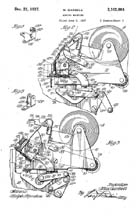
The Victor Adding Machine Patents
Patent Nos 2,311,928, 2,277,498 and 2,102,693
Click to Enlarge
Click here if you want to learn how to get Free Patent Drawings
The Victor Adding Machine Company was incorporated in 1918 in Springfield, Illinois. Carl Bueler invested heavily in the company and under his control and then that of his son A.C. Bueler the company became very successful in the field of low cost, but high quality machines that performed calculations and printed the results. In 1961 the Comptometer Corporation merged with Victor to form the Victor Comptometer Corporation. The Victor company is still in the calculator business, after several changes of ownership, and has a time line of the company's history on the Firm's Website.


Victor Adding Machine Ephemera
Stock Certificate for the Victor-Comptometer Company
Victor Magazine Advertiesement from the 1940s
Click to Enlarge
We have seen these at Art Deco shows in the neighborhood of $200. We found this perfect specimen in an office supplies store in Baltimore --- I described what I was looking for and the owner pulled this from a box in the corner. It had been left for repair in 1975 and had not been claimed. He gave it to us for the amount on the ticket -- $12.95. I think that this repair ticket is as interesting as the machine itself
Click here to look at another type of collectible, or keep on scrolling for more Knicknacks.

St. Vincent De Paul
A noteworthy man
Click to Enlarge
We found this very nice porcelain statuette of St. Vincent De Paul at a yard sale we believe that it dates from the 1920s. Those of you who have read the Serial know that I have a very special affection for Saint Vincent. I'd like to present this small biography of Saint Vincent for those who only know him from the chain of thrift stores that bear his name.
St Vincent De Paul
St. Vincent De Paul was born in 1581, near the village of Pouy, France some 60 miles north- east of Lourdes. He studied Theology at Toulouse and was ordained a priest in 1600. In his early days he worked on the missions in North Africa where he was captured and enslaved. After his release he was assigned to the court of King Henry of France. While in Paris St. Vincent realised that his true vocation lay in the service of the poor and not in the courts of royalty. For the rest of his life he committed himself to this task. He died in 1660.
While a Parish Priest in the little French country village of Chatillon le Dombes, he was approached by a woman who's family lived on the outskirts of the village and desperately in need of assistance. Not only did St. Vincent speak about this family to the congregation; he enlarged on the duty of every Christian to help his neighbour, particularly the poor and especially the sick.
His words reached the hearts of his congregation and for the rest of the day there was a regular procession from the village carrying food to the family. Though the people were very generous, their charity was badly organised. A large quantity of food had been brought, some of which would have gone bad before the family were able to use it. And when their provisions had been exhausted they would once again find themselves on the verge of starvation.
It was because of this that St. Vincent De Paul thought of the idea to organising the regular distribution of relief to the poor, and of having special visits beforehand to their homes to find out their circumstances. With several ladies in his parish he discussed his project. From this group of women he was able to found the Sisters of Charity of St. Vincent De Paul (The 'Daughters of Charity'). Later on he also founded a congregation of Priests - the 'Vincentians', and a lay society of women - The Ladies of Charity.
Click here to look at another type of collectible.

Harry Richman Envelope Cigarette Case
Harry was a promoter....
Click to Enlarge
This item sort of leaped out at us at a flea market. It is a cigarette case in the form of an envelope, including an official real US Postage stamp from the 1939 World's Fair. The interesting thing is that the case was sold at the fair as a somewhat expensive trinket -- the address of the individual was engraved right there on the spot. I don't think that you could drop it in a mailbox, though because 3 cents wouldn't take it that far, even in 1939.


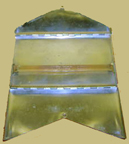
Harry Richman Envelope Cigarette Case
Emanuel Hammerling Patent No. 2,181,993
Click to Enlarge
Our research on this object has turned up a number of quirky facts that might amuse our readers. The item was patented by Emanuel Hammerling but sold (at least in its World's Fair incarnation) by "Harry Richman Novelties."
About Harry Richman...
Harry Richman –3 November 1972) was an American entertainer. He was a singer, actor, dancer, comedian, pianist, songwriter, bandleader, and night club performer, at his most popular in the 1920s and 1930s.
Richman was born as Harold Reichman in Cincinnati, Ohio on August 10, 1895. He changed his name to "Harry Richman" at age 18, having become a professional entertainer in vaudeville. He worked as a piano accompanist to such stars as Mae West and Nora Bayes and made his Broadway debut in 1922. He appeared in several editions of the George White's Scandals in the 1920s to acclaim. He appeared in the 1931 Ziegfeld Follies.
He made his feature movie debut in Hollywood in 1930 with the film Puttin' on the Ritz, featuring the Irving Berlin song of the same title. His recording of that song became a hit that year. His performance gathered neither critical acclaim nor box-office. He retained a measure of popularity as a nightclub host and stage performer. He also made regular radio broadcasts in the 1930s. Richman largely retired in the 1940s, although he made irregular appearances, on both radio and television, into the 1950s. As we have seen above, he also engaged in a variety of non-theatrical schemes to earn money.
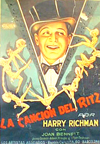



Harry Richman's Multi-faceted Career
Read about the "Ping-Pong Flight"
Click to Enlarge
Richman was also an amateur aviator, being the co-pilot in 1936, with famed flyer Henry Tindall "Dick" Merrill, of the first round-trip Trans-Atlantic flight in his own single-engine Vultee transport. Richman had filled much of the empty space of the aircraft with ping pong balls as a flotation aid in case they were forced down in the Atlantic. Although the flight was successful and even held the speed record for a few months, it cost richman $360,000 in 1936 (about $10 million in 2010). In order to recoup the cost, he sold autographed ping-pong balls until his death. They continue to turn up on eBay to this day.
His autobiography A Hell of a Life was published in 1966. Harry Richman died in Hollywood, California on November 3, 1972).
Click here to look at another type of collectible.
Counter for the Entire Site (not just this page..)
Home | About Lindy | 1940s Collectibles | Upcoming Events | Vintage Clothing
The Guide - Establishments - Travel - Accessories
Music | Links | Photo Gallery | Extras | Contact